Plant and Equipment Asset Management Plan
VerifiedAdded on 2023/01/16
|26
|5635
|42
AI Summary
This document is a Plant and Equipment Asset Management Plan that outlines strategies for managing and optimizing assets for efficient service delivery. It covers topics such as funding, levels of service, demand management, and lifecycle management. The plan aims to provide a financially sustainable approach to asset management and ensure the desired levels of service are met.
Contribute Materials
Your contribution can guide someone’s learning journey. Share your
documents today.
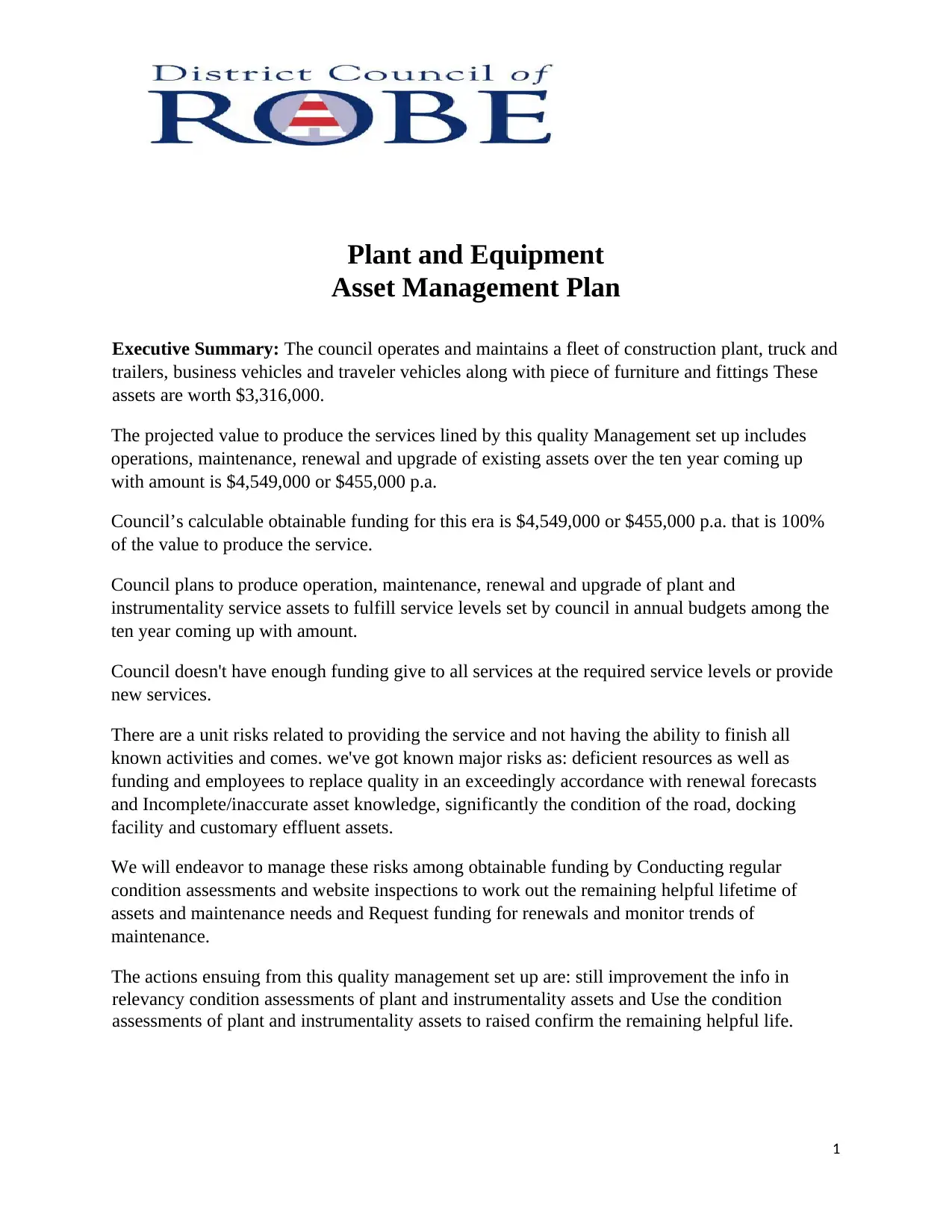
Plant and Equipment
Asset Management Plan
Executive Summary: The council operates and maintains a fleet of construction plant, truck and
trailers, business vehicles and traveler vehicles along with piece of furniture and fittings These
assets are worth $3,316,000.
The projected value to produce the services lined by this quality Management set up includes
operations, maintenance, renewal and upgrade of existing assets over the ten year coming up
with amount is $4,549,000 or $455,000 p.a.
Council’s calculable obtainable funding for this era is $4,549,000 or $455,000 p.a. that is 100%
of the value to produce the service.
Council plans to produce operation, maintenance, renewal and upgrade of plant and
instrumentality service assets to fulfill service levels set by council in annual budgets among the
ten year coming up with amount.
Council doesn't have enough funding give to all services at the required service levels or provide
new services.
There are a unit risks related to providing the service and not having the ability to finish all
known activities and comes. we've got known major risks as: deficient resources as well as
funding and employees to replace quality in an exceedingly accordance with renewal forecasts
and Incomplete/inaccurate asset knowledge, significantly the condition of the road, docking
facility and customary effluent assets.
We will endeavor to manage these risks among obtainable funding by Conducting regular
condition assessments and website inspections to work out the remaining helpful lifetime of
assets and maintenance needs and Request funding for renewals and monitor trends of
maintenance.
The actions ensuing from this quality management set up are: still improvement the info in
relevancy condition assessments of plant and instrumentality assets and Use the condition
assessments of plant and instrumentality assets to raised confirm the remaining helpful life.
1
Asset Management Plan
Executive Summary: The council operates and maintains a fleet of construction plant, truck and
trailers, business vehicles and traveler vehicles along with piece of furniture and fittings These
assets are worth $3,316,000.
The projected value to produce the services lined by this quality Management set up includes
operations, maintenance, renewal and upgrade of existing assets over the ten year coming up
with amount is $4,549,000 or $455,000 p.a.
Council’s calculable obtainable funding for this era is $4,549,000 or $455,000 p.a. that is 100%
of the value to produce the service.
Council plans to produce operation, maintenance, renewal and upgrade of plant and
instrumentality service assets to fulfill service levels set by council in annual budgets among the
ten year coming up with amount.
Council doesn't have enough funding give to all services at the required service levels or provide
new services.
There are a unit risks related to providing the service and not having the ability to finish all
known activities and comes. we've got known major risks as: deficient resources as well as
funding and employees to replace quality in an exceedingly accordance with renewal forecasts
and Incomplete/inaccurate asset knowledge, significantly the condition of the road, docking
facility and customary effluent assets.
We will endeavor to manage these risks among obtainable funding by Conducting regular
condition assessments and website inspections to work out the remaining helpful lifetime of
assets and maintenance needs and Request funding for renewals and monitor trends of
maintenance.
The actions ensuing from this quality management set up are: still improvement the info in
relevancy condition assessments of plant and instrumentality assets and Use the condition
assessments of plant and instrumentality assets to raised confirm the remaining helpful life.
1
Secure Best Marks with AI Grader
Need help grading? Try our AI Grader for instant feedback on your assignments.
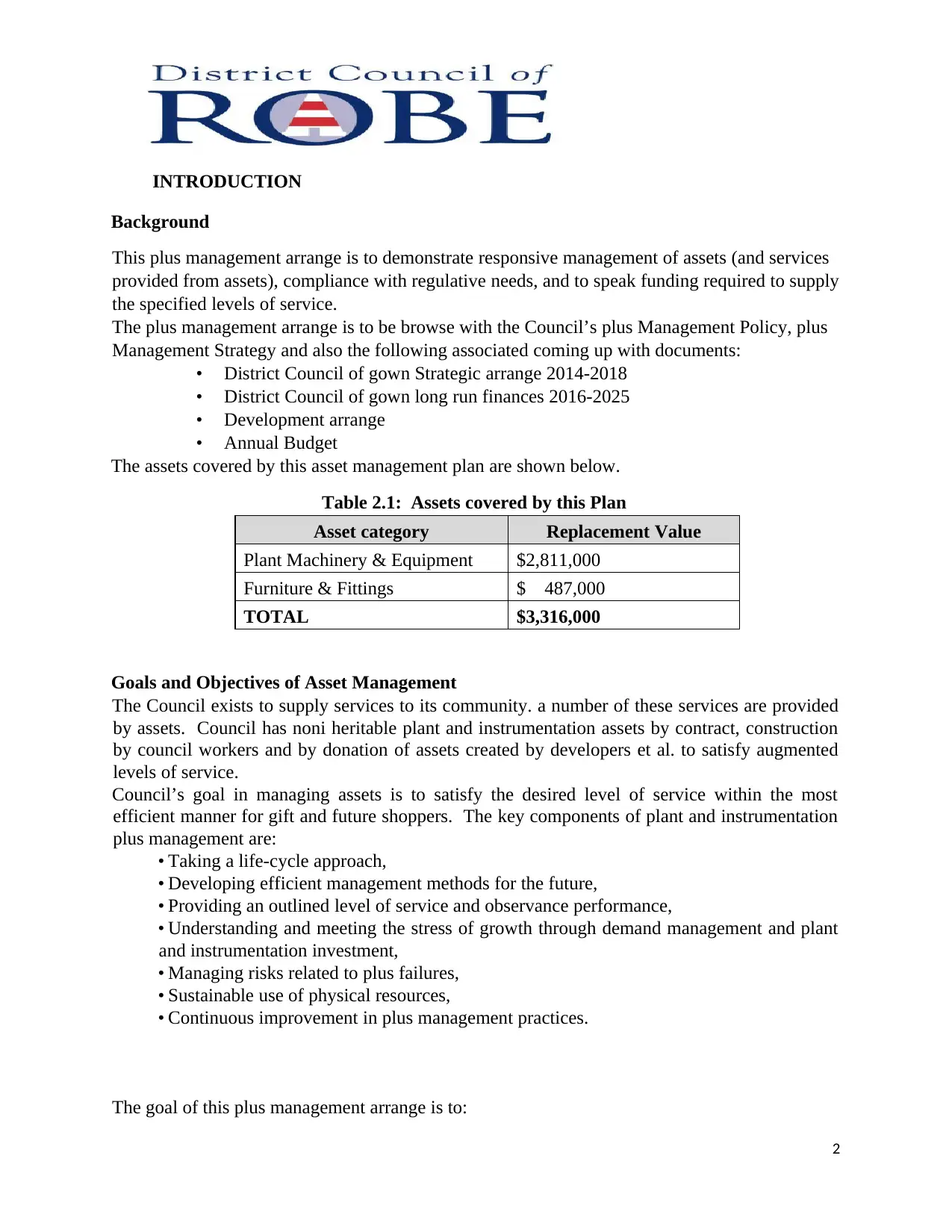
INTRODUCTION
Background
This plus management arrange is to demonstrate responsive management of assets (and services
provided from assets), compliance with regulative needs, and to speak funding required to supply
the specified levels of service.
The plus management arrange is to be browse with the Council’s plus Management Policy, plus
Management Strategy and also the following associated coming up with documents:
• District Council of gown Strategic arrange 2014-2018
• District Council of gown long run finances 2016-2025
• Development arrange
• Annual Budget
The assets covered by this asset management plan are shown below.
Table 2.1: Assets covered by this Plan
Asset category Replacement Value
Plant Machinery & Equipment $2,811,000
Furniture & Fittings $ 487,000
TOTAL $3,316,000
Goals and Objectives of Asset Management
The Council exists to supply services to its community. a number of these services are provided
by assets. Council has noni heritable plant and instrumentation assets by contract, construction
by council workers and by donation of assets created by developers et al. to satisfy augmented
levels of service.
Council’s goal in managing assets is to satisfy the desired level of service within the most
efficient manner for gift and future shoppers. The key components of plant and instrumentation
plus management are:
• Taking a life-cycle approach,
• Developing efficient management methods for the future,
• Providing an outlined level of service and observance performance,
• Understanding and meeting the stress of growth through demand management and plant
and instrumentation investment,
• Managing risks related to plus failures,
• Sustainable use of physical resources,
• Continuous improvement in plus management practices.
The goal of this plus management arrange is to:
2
Background
This plus management arrange is to demonstrate responsive management of assets (and services
provided from assets), compliance with regulative needs, and to speak funding required to supply
the specified levels of service.
The plus management arrange is to be browse with the Council’s plus Management Policy, plus
Management Strategy and also the following associated coming up with documents:
• District Council of gown Strategic arrange 2014-2018
• District Council of gown long run finances 2016-2025
• Development arrange
• Annual Budget
The assets covered by this asset management plan are shown below.
Table 2.1: Assets covered by this Plan
Asset category Replacement Value
Plant Machinery & Equipment $2,811,000
Furniture & Fittings $ 487,000
TOTAL $3,316,000
Goals and Objectives of Asset Management
The Council exists to supply services to its community. a number of these services are provided
by assets. Council has noni heritable plant and instrumentation assets by contract, construction
by council workers and by donation of assets created by developers et al. to satisfy augmented
levels of service.
Council’s goal in managing assets is to satisfy the desired level of service within the most
efficient manner for gift and future shoppers. The key components of plant and instrumentation
plus management are:
• Taking a life-cycle approach,
• Developing efficient management methods for the future,
• Providing an outlined level of service and observance performance,
• Understanding and meeting the stress of growth through demand management and plant
and instrumentation investment,
• Managing risks related to plus failures,
• Sustainable use of physical resources,
• Continuous improvement in plus management practices.
The goal of this plus management arrange is to:
2
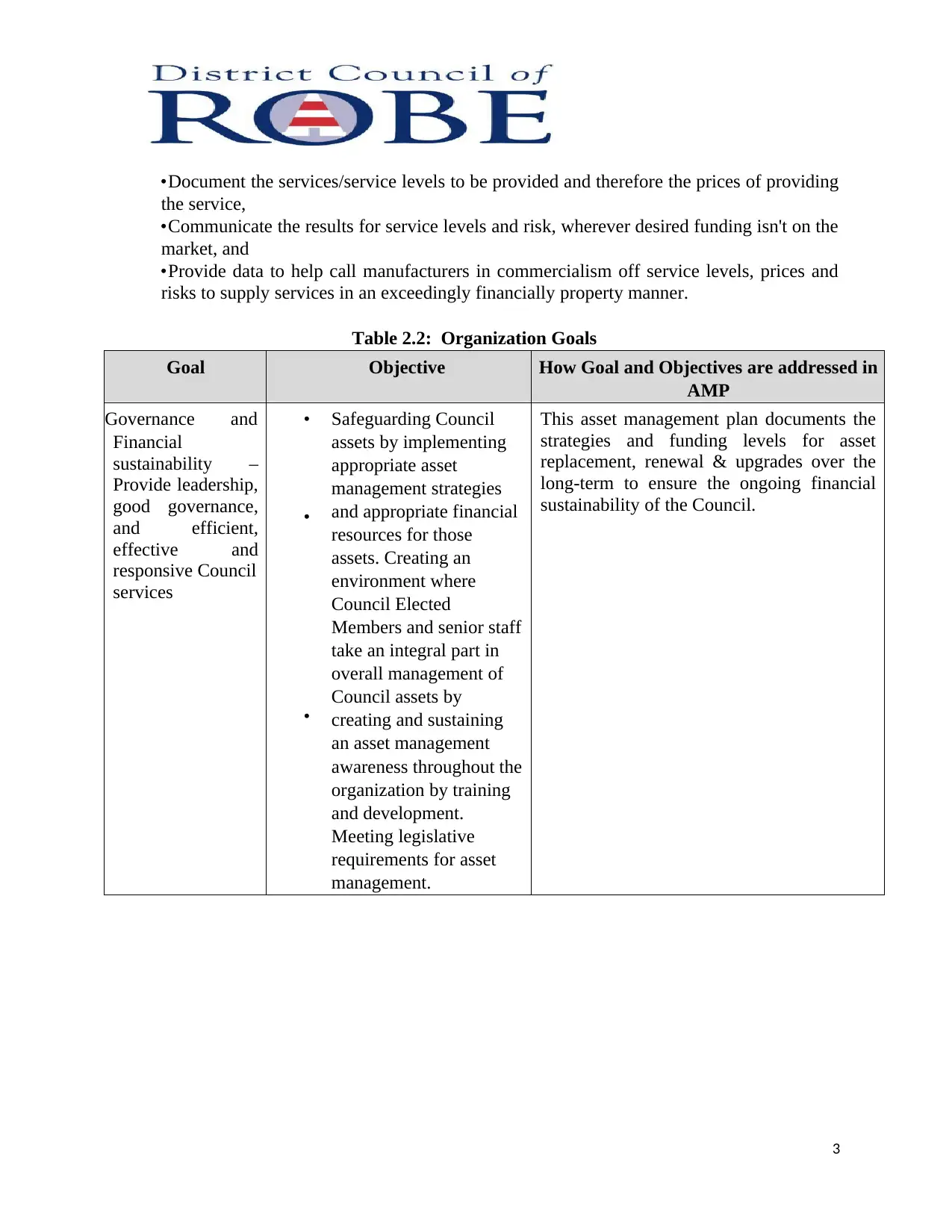
•Document the services/service levels to be provided and therefore the prices of providing
the service,
•Communicate the results for service levels and risk, wherever desired funding isn't on the
market, and
•Provide data to help call manufacturers in commercialism off service levels, prices and
risks to supply services in an exceedingly financially property manner.
Table 2.2: Organization Goals
Goal Objective How Goal and Objectives are addressed in
AMP
Governance and
Financial
sustainability –
Provide leadership,
good governance,
and efficient,
effective and
responsive Council
services
•
•
•
Safeguarding Council
assets by implementing
appropriate asset
management strategies
and appropriate financial
resources for those
assets. Creating an
environment where
Council Elected
Members and senior staff
take an integral part in
overall management of
Council assets by
creating and sustaining
an asset management
awareness throughout the
organization by training
and development.
Meeting legislative
requirements for asset
management.
This asset management plan documents the
strategies and funding levels for asset
replacement, renewal & upgrades over the
long-term to ensure the ongoing financial
sustainability of the Council.
3
the service,
•Communicate the results for service levels and risk, wherever desired funding isn't on the
market, and
•Provide data to help call manufacturers in commercialism off service levels, prices and
risks to supply services in an exceedingly financially property manner.
Table 2.2: Organization Goals
Goal Objective How Goal and Objectives are addressed in
AMP
Governance and
Financial
sustainability –
Provide leadership,
good governance,
and efficient,
effective and
responsive Council
services
•
•
•
Safeguarding Council
assets by implementing
appropriate asset
management strategies
and appropriate financial
resources for those
assets. Creating an
environment where
Council Elected
Members and senior staff
take an integral part in
overall management of
Council assets by
creating and sustaining
an asset management
awareness throughout the
organization by training
and development.
Meeting legislative
requirements for asset
management.
This asset management plan documents the
strategies and funding levels for asset
replacement, renewal & upgrades over the
long-term to ensure the ongoing financial
sustainability of the Council.
3
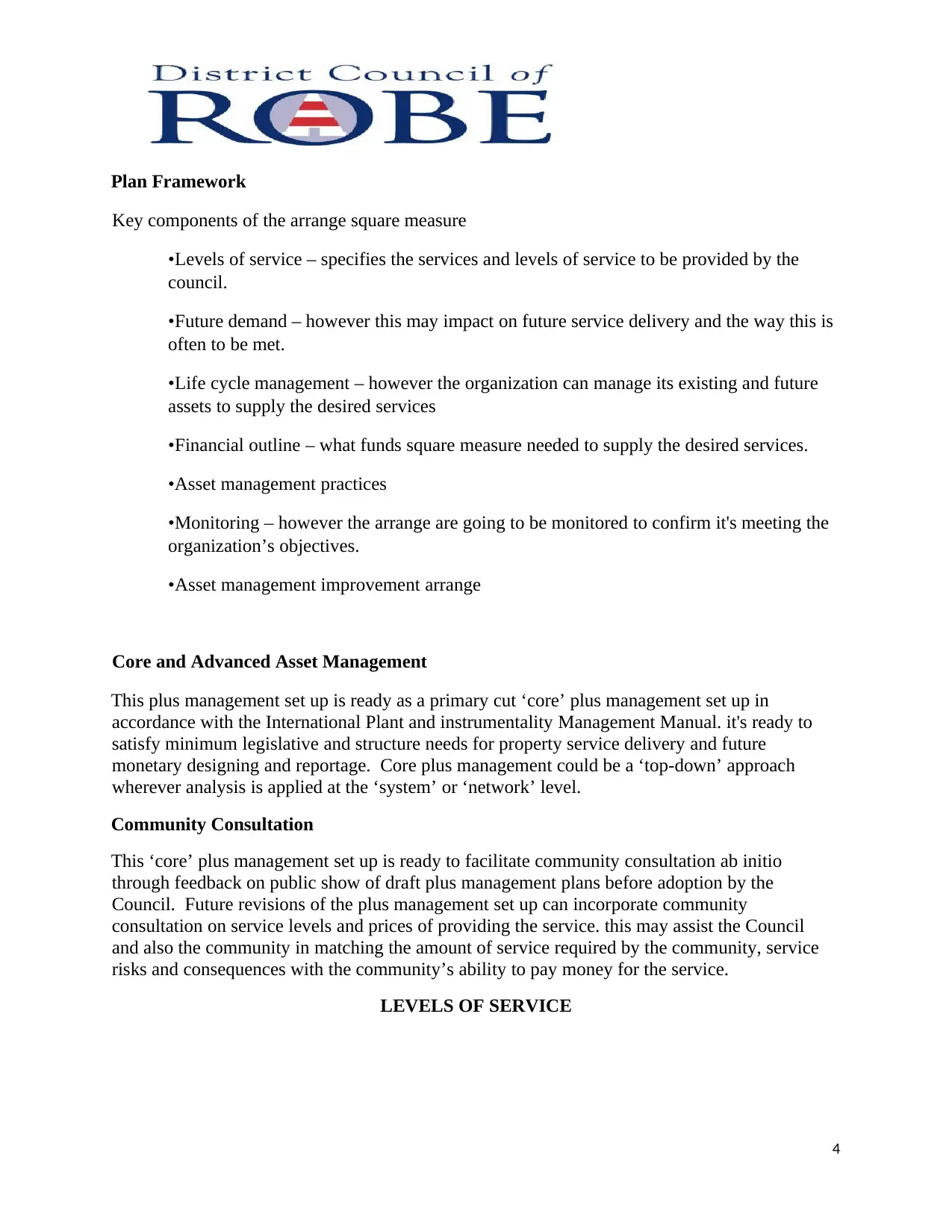
Plan Framework
Key components of the arrange square measure
•Levels of service – specifies the services and levels of service to be provided by the
council.
•Future demand – however this may impact on future service delivery and the way this is
often to be met.
•Life cycle management – however the organization can manage its existing and future
assets to supply the desired services
•Financial outline – what funds square measure needed to supply the desired services.
•Asset management practices
•Monitoring – however the arrange are going to be monitored to confirm it's meeting the
organization’s objectives.
•Asset management improvement arrange
Core and Advanced Asset Management
This plus management set up is ready as a primary cut ‘core’ plus management set up in
accordance with the International Plant and instrumentality Management Manual. it's ready to
satisfy minimum legislative and structure needs for property service delivery and future
monetary designing and reportage. Core plus management could be a ‘top-down’ approach
wherever analysis is applied at the ‘system’ or ‘network’ level.
Community Consultation
This ‘core’ plus management set up is ready to facilitate community consultation ab initio
through feedback on public show of draft plus management plans before adoption by the
Council. Future revisions of the plus management set up can incorporate community
consultation on service levels and prices of providing the service. this may assist the Council
and also the community in matching the amount of service required by the community, service
risks and consequences with the community’s ability to pay money for the service.
LEVELS OF SERVICE
4
Key components of the arrange square measure
•Levels of service – specifies the services and levels of service to be provided by the
council.
•Future demand – however this may impact on future service delivery and the way this is
often to be met.
•Life cycle management – however the organization can manage its existing and future
assets to supply the desired services
•Financial outline – what funds square measure needed to supply the desired services.
•Asset management practices
•Monitoring – however the arrange are going to be monitored to confirm it's meeting the
organization’s objectives.
•Asset management improvement arrange
Core and Advanced Asset Management
This plus management set up is ready as a primary cut ‘core’ plus management set up in
accordance with the International Plant and instrumentality Management Manual. it's ready to
satisfy minimum legislative and structure needs for property service delivery and future
monetary designing and reportage. Core plus management could be a ‘top-down’ approach
wherever analysis is applied at the ‘system’ or ‘network’ level.
Community Consultation
This ‘core’ plus management set up is ready to facilitate community consultation ab initio
through feedback on public show of draft plus management plans before adoption by the
Council. Future revisions of the plus management set up can incorporate community
consultation on service levels and prices of providing the service. this may assist the Council
and also the community in matching the amount of service required by the community, service
risks and consequences with the community’s ability to pay money for the service.
LEVELS OF SERVICE
4
Secure Best Marks with AI Grader
Need help grading? Try our AI Grader for instant feedback on your assignments.
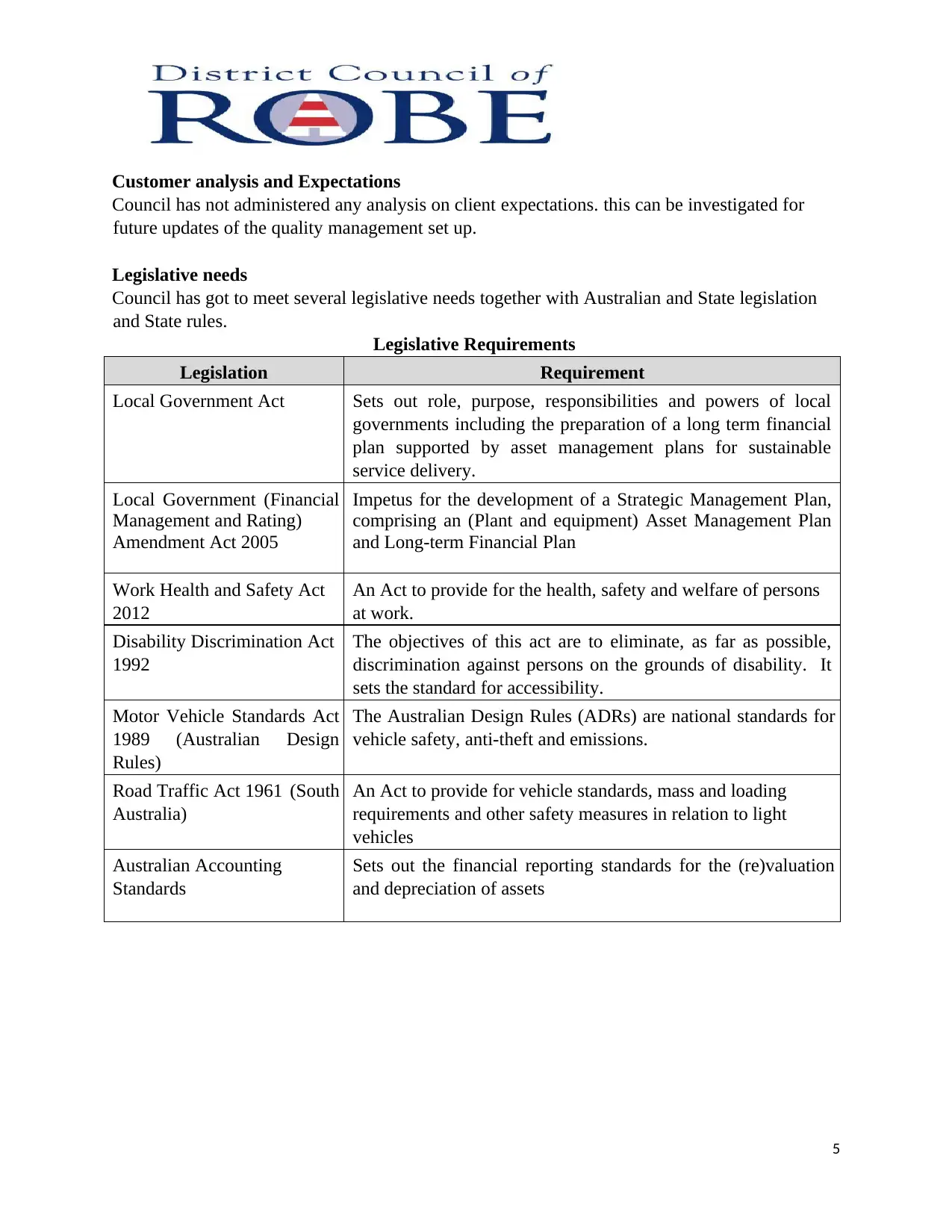
Customer analysis and Expectations
Council has not administered any analysis on client expectations. this can be investigated for
future updates of the quality management set up.
Legislative needs
Council has got to meet several legislative needs together with Australian and State legislation
and State rules.
Legislative Requirements
Legislation Requirement
Local Government Act Sets out role, purpose, responsibilities and powers of local
governments including the preparation of a long term financial
plan supported by asset management plans for sustainable
service delivery.
Local Government (Financial
Management and Rating)
Amendment Act 2005
Impetus for the development of a Strategic Management Plan,
comprising an (Plant and equipment) Asset Management Plan
and Long-term Financial Plan
Work Health and Safety Act
2012
An Act to provide for the health, safety and welfare of persons
at work.
Disability Discrimination Act
1992
The objectives of this act are to eliminate, as far as possible,
discrimination against persons on the grounds of disability. It
sets the standard for accessibility.
Motor Vehicle Standards Act
1989 (Australian Design
Rules)
The Australian Design Rules (ADRs) are national standards for
vehicle safety, anti-theft and emissions.
Road Traffic Act 1961 (South
Australia)
An Act to provide for vehicle standards, mass and loading
requirements and other safety measures in relation to light
vehicles
Australian Accounting
Standards
Sets out the financial reporting standards for the (re)valuation
and depreciation of assets
5
Council has not administered any analysis on client expectations. this can be investigated for
future updates of the quality management set up.
Legislative needs
Council has got to meet several legislative needs together with Australian and State legislation
and State rules.
Legislative Requirements
Legislation Requirement
Local Government Act Sets out role, purpose, responsibilities and powers of local
governments including the preparation of a long term financial
plan supported by asset management plans for sustainable
service delivery.
Local Government (Financial
Management and Rating)
Amendment Act 2005
Impetus for the development of a Strategic Management Plan,
comprising an (Plant and equipment) Asset Management Plan
and Long-term Financial Plan
Work Health and Safety Act
2012
An Act to provide for the health, safety and welfare of persons
at work.
Disability Discrimination Act
1992
The objectives of this act are to eliminate, as far as possible,
discrimination against persons on the grounds of disability. It
sets the standard for accessibility.
Motor Vehicle Standards Act
1989 (Australian Design
Rules)
The Australian Design Rules (ADRs) are national standards for
vehicle safety, anti-theft and emissions.
Road Traffic Act 1961 (South
Australia)
An Act to provide for vehicle standards, mass and loading
requirements and other safety measures in relation to light
vehicles
Australian Accounting
Standards
Sets out the financial reporting standards for the (re)valuation
and depreciation of assets
5
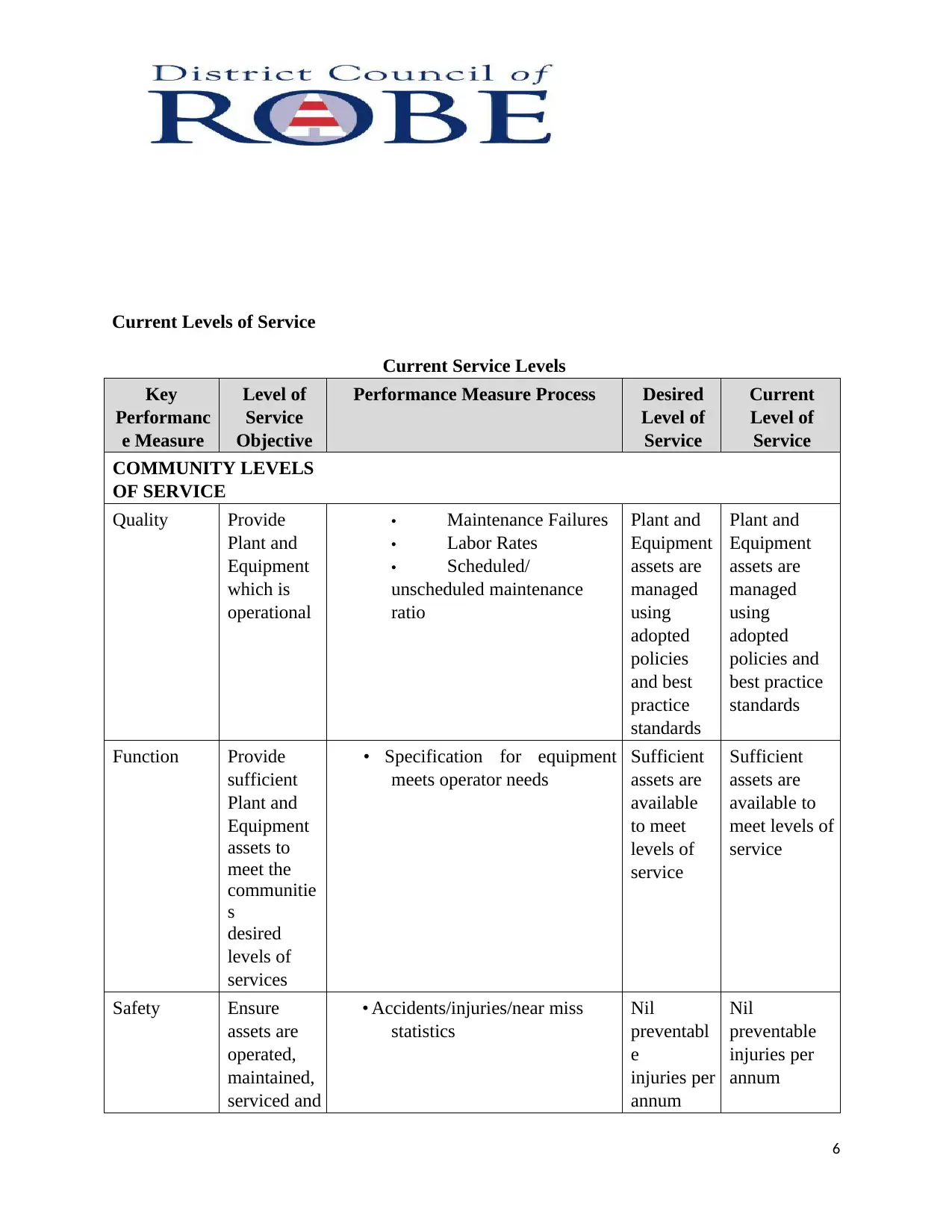
Current Levels of Service
Current Service Levels
Key
Performanc
e Measure
Level of
Service
Objective
Performance Measure Process Desired
Level of
Service
Current
Level of
Service
COMMUNITY LEVELS
OF SERVICE
Quality Provide
Plant and
Equipment
which is
operational
• Maintenance Failures
• Labor Rates
• Scheduled/
unscheduled maintenance
ratio
Plant and
Equipment
assets are
managed
using
adopted
policies
and best
practice
standards
Plant and
Equipment
assets are
managed
using
adopted
policies and
best practice
standards
Function Provide
sufficient
Plant and
Equipment
assets to
meet the
communitie
s
desired
levels of
services
• Specification for equipment
meets operator needs
Sufficient
assets are
available
to meet
levels of
service
Sufficient
assets are
available to
meet levels of
service
Safety Ensure
assets are
operated,
maintained,
serviced and
• Accidents/injuries/near miss
statistics
Nil
preventabl
e
injuries per
annum
Nil
preventable
injuries per
annum
6
Current Service Levels
Key
Performanc
e Measure
Level of
Service
Objective
Performance Measure Process Desired
Level of
Service
Current
Level of
Service
COMMUNITY LEVELS
OF SERVICE
Quality Provide
Plant and
Equipment
which is
operational
• Maintenance Failures
• Labor Rates
• Scheduled/
unscheduled maintenance
ratio
Plant and
Equipment
assets are
managed
using
adopted
policies
and best
practice
standards
Plant and
Equipment
assets are
managed
using
adopted
policies and
best practice
standards
Function Provide
sufficient
Plant and
Equipment
assets to
meet the
communitie
s
desired
levels of
services
• Specification for equipment
meets operator needs
Sufficient
assets are
available
to meet
levels of
service
Sufficient
assets are
available to
meet levels of
service
Safety Ensure
assets are
operated,
maintained,
serviced and
• Accidents/injuries/near miss
statistics
Nil
preventabl
e
injuries per
annum
Nil
preventable
injuries per
annum
6
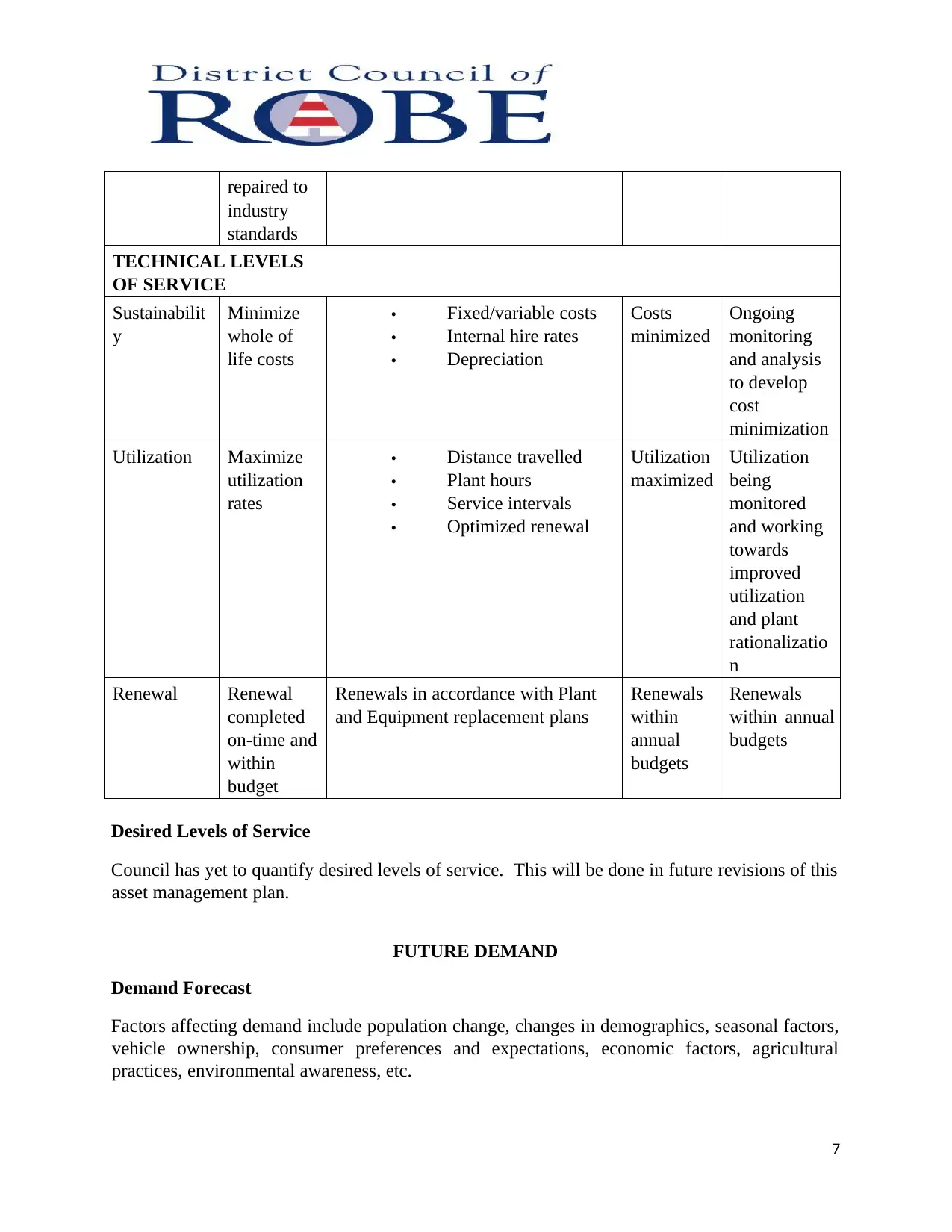
repaired to
industry
standards
TECHNICAL LEVELS
OF SERVICE
Sustainabilit
y
Minimize
whole of
life costs
• Fixed/variable costs
• Internal hire rates
• Depreciation
Costs
minimized
Ongoing
monitoring
and analysis
to develop
cost
minimization
Utilization Maximize
utilization
rates
• Distance travelled
• Plant hours
• Service intervals
• Optimized renewal
Utilization
maximized
Utilization
being
monitored
and working
towards
improved
utilization
and plant
rationalizatio
n
Renewal Renewal
completed
on-time and
within
budget
Renewals in accordance with Plant
and Equipment replacement plans
Renewals
within
annual
budgets
Renewals
within annual
budgets
Desired Levels of Service
Council has yet to quantify desired levels of service. This will be done in future revisions of this
asset management plan.
FUTURE DEMAND
Demand Forecast
Factors affecting demand include population change, changes in demographics, seasonal factors,
vehicle ownership, consumer preferences and expectations, economic factors, agricultural
practices, environmental awareness, etc.
7
industry
standards
TECHNICAL LEVELS
OF SERVICE
Sustainabilit
y
Minimize
whole of
life costs
• Fixed/variable costs
• Internal hire rates
• Depreciation
Costs
minimized
Ongoing
monitoring
and analysis
to develop
cost
minimization
Utilization Maximize
utilization
rates
• Distance travelled
• Plant hours
• Service intervals
• Optimized renewal
Utilization
maximized
Utilization
being
monitored
and working
towards
improved
utilization
and plant
rationalizatio
n
Renewal Renewal
completed
on-time and
within
budget
Renewals in accordance with Plant
and Equipment replacement plans
Renewals
within
annual
budgets
Renewals
within annual
budgets
Desired Levels of Service
Council has yet to quantify desired levels of service. This will be done in future revisions of this
asset management plan.
FUTURE DEMAND
Demand Forecast
Factors affecting demand include population change, changes in demographics, seasonal factors,
vehicle ownership, consumer preferences and expectations, economic factors, agricultural
practices, environmental awareness, etc.
7
Paraphrase This Document
Need a fresh take? Get an instant paraphrase of this document with our AI Paraphraser
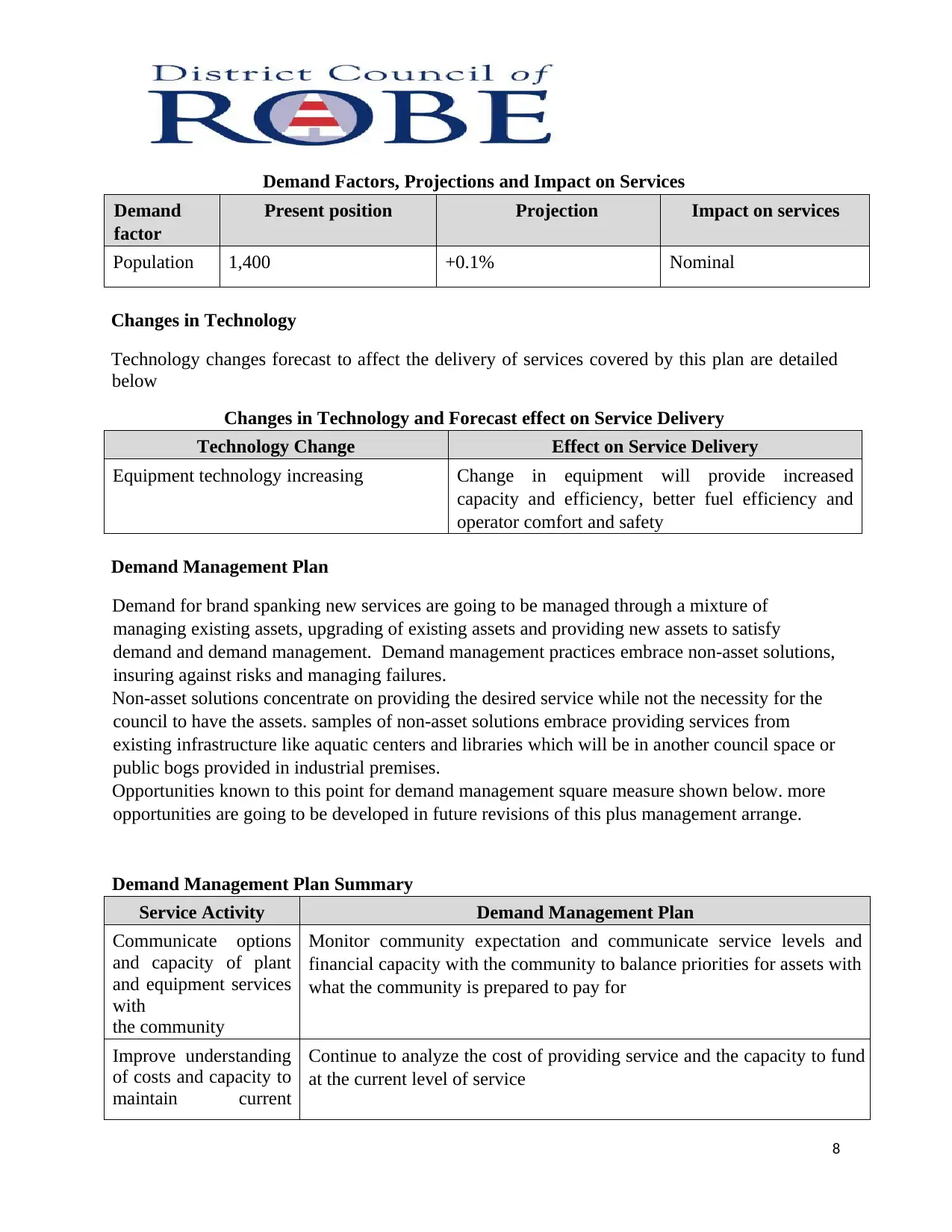
Demand Factors, Projections and Impact on Services
Demand
factor
Present position Projection Impact on services
Population 1,400 +0.1% Nominal
Changes in Technology
Technology changes forecast to affect the delivery of services covered by this plan are detailed
below
Changes in Technology and Forecast effect on Service Delivery
Technology Change Effect on Service Delivery
Equipment technology increasing Change in equipment will provide increased
capacity and efficiency, better fuel efficiency and
operator comfort and safety
Demand Management Plan
Demand for brand spanking new services are going to be managed through a mixture of
managing existing assets, upgrading of existing assets and providing new assets to satisfy
demand and demand management. Demand management practices embrace non-asset solutions,
insuring against risks and managing failures.
Non-asset solutions concentrate on providing the desired service while not the necessity for the
council to have the assets. samples of non-asset solutions embrace providing services from
existing infrastructure like aquatic centers and libraries which will be in another council space or
public bogs provided in industrial premises.
Opportunities known to this point for demand management square measure shown below. more
opportunities are going to be developed in future revisions of this plus management arrange.
Demand Management Plan Summary
Service Activity Demand Management Plan
Communicate options
and capacity of plant
and equipment services
with
the community
Monitor community expectation and communicate service levels and
financial capacity with the community to balance priorities for assets with
what the community is prepared to pay for
Improve understanding
of costs and capacity to
maintain current
Continue to analyze the cost of providing service and the capacity to fund
at the current level of service
8
Demand
factor
Present position Projection Impact on services
Population 1,400 +0.1% Nominal
Changes in Technology
Technology changes forecast to affect the delivery of services covered by this plan are detailed
below
Changes in Technology and Forecast effect on Service Delivery
Technology Change Effect on Service Delivery
Equipment technology increasing Change in equipment will provide increased
capacity and efficiency, better fuel efficiency and
operator comfort and safety
Demand Management Plan
Demand for brand spanking new services are going to be managed through a mixture of
managing existing assets, upgrading of existing assets and providing new assets to satisfy
demand and demand management. Demand management practices embrace non-asset solutions,
insuring against risks and managing failures.
Non-asset solutions concentrate on providing the desired service while not the necessity for the
council to have the assets. samples of non-asset solutions embrace providing services from
existing infrastructure like aquatic centers and libraries which will be in another council space or
public bogs provided in industrial premises.
Opportunities known to this point for demand management square measure shown below. more
opportunities are going to be developed in future revisions of this plus management arrange.
Demand Management Plan Summary
Service Activity Demand Management Plan
Communicate options
and capacity of plant
and equipment services
with
the community
Monitor community expectation and communicate service levels and
financial capacity with the community to balance priorities for assets with
what the community is prepared to pay for
Improve understanding
of costs and capacity to
maintain current
Continue to analyze the cost of providing service and the capacity to fund
at the current level of service
8
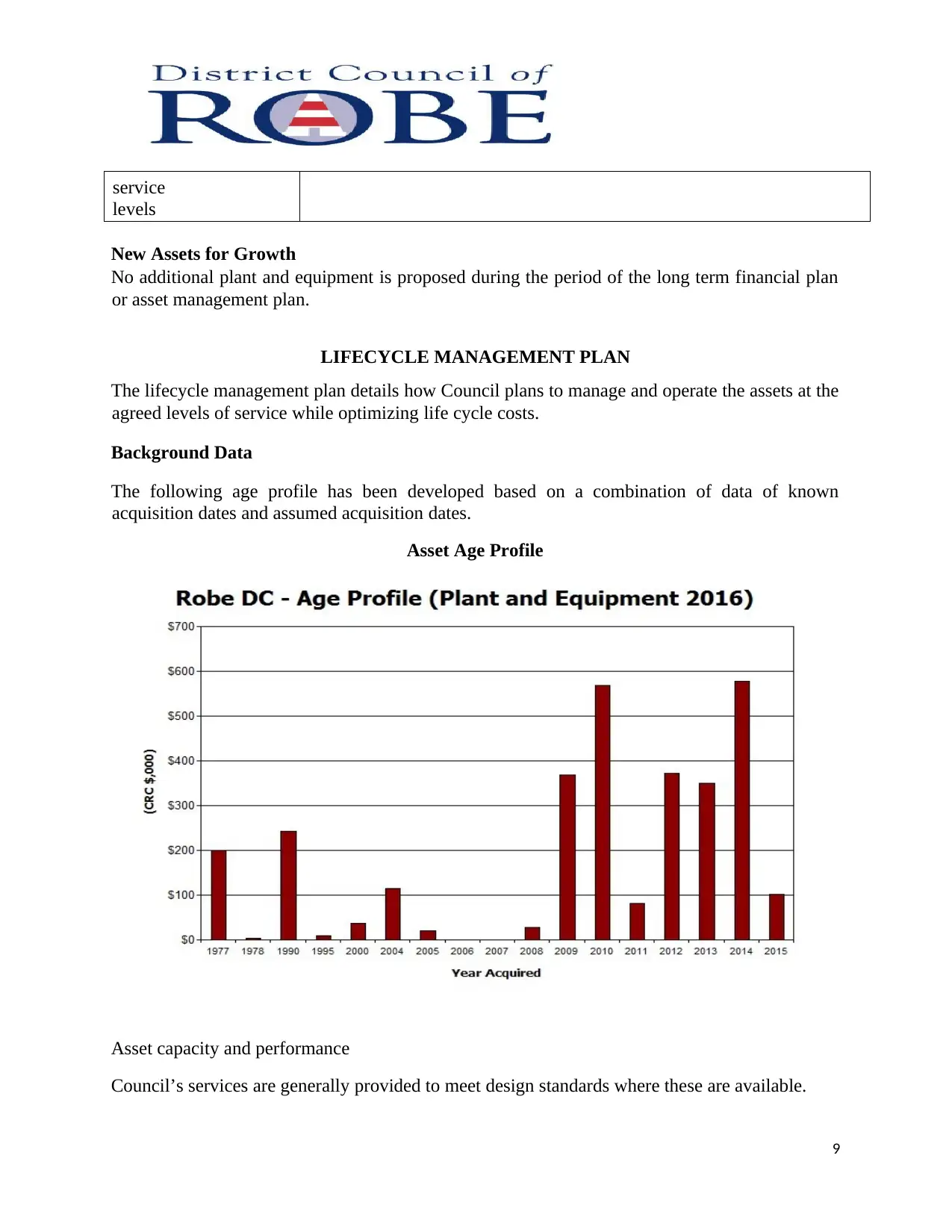
service
levels
New Assets for Growth
No additional plant and equipment is proposed during the period of the long term financial plan
or asset management plan.
LIFECYCLE MANAGEMENT PLAN
The lifecycle management plan details how Council plans to manage and operate the assets at the
agreed levels of service while optimizing life cycle costs.
Background Data
The following age profile has been developed based on a combination of data of known
acquisition dates and assumed acquisition dates.
Asset Age Profile
Asset capacity and performance
Council’s services are generally provided to meet design standards where these are available.
9
levels
New Assets for Growth
No additional plant and equipment is proposed during the period of the long term financial plan
or asset management plan.
LIFECYCLE MANAGEMENT PLAN
The lifecycle management plan details how Council plans to manage and operate the assets at the
agreed levels of service while optimizing life cycle costs.
Background Data
The following age profile has been developed based on a combination of data of known
acquisition dates and assumed acquisition dates.
Asset Age Profile
Asset capacity and performance
Council’s services are generally provided to meet design standards where these are available.
9
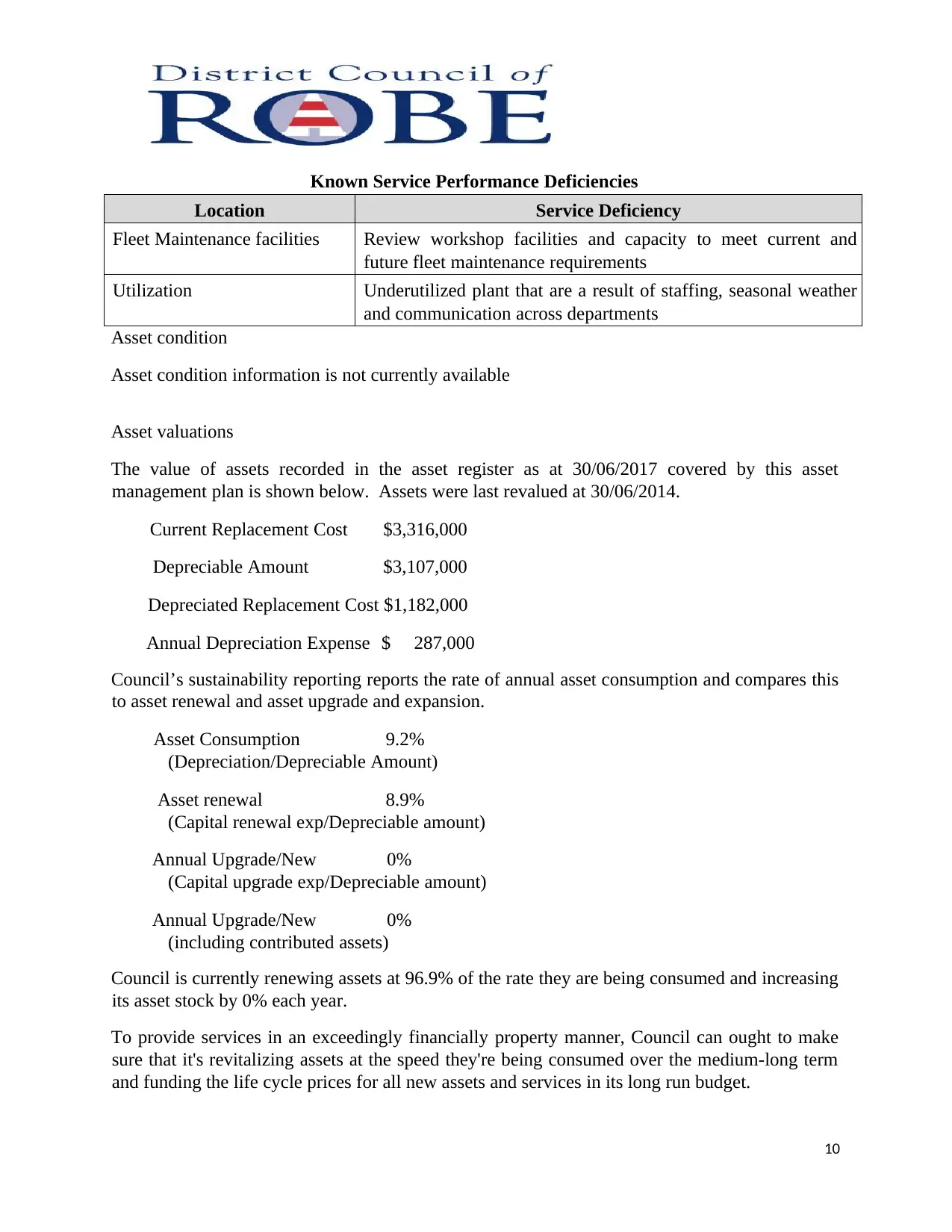
Known Service Performance Deficiencies
Location Service Deficiency
Fleet Maintenance facilities Review workshop facilities and capacity to meet current and
future fleet maintenance requirements
Utilization Underutilized plant that are a result of staffing, seasonal weather
and communication across departments
Asset condition
Asset condition information is not currently available
Asset valuations
The value of assets recorded in the asset register as at 30/06/2017 covered by this asset
management plan is shown below. Assets were last revalued at 30/06/2014.
Current Replacement Cost $3,316,000
Depreciable Amount $3,107,000
Depreciated Replacement Cost $1,182,000
Annual Depreciation Expense $ 287,000
Council’s sustainability reporting reports the rate of annual asset consumption and compares this
to asset renewal and asset upgrade and expansion.
Asset Consumption 9.2%
(Depreciation/Depreciable Amount)
Asset renewal 8.9%
(Capital renewal exp/Depreciable amount)
Annual Upgrade/New 0%
(Capital upgrade exp/Depreciable amount)
Annual Upgrade/New 0%
(including contributed assets)
Council is currently renewing assets at 96.9% of the rate they are being consumed and increasing
its asset stock by 0% each year.
To provide services in an exceedingly financially property manner, Council can ought to make
sure that it's revitalizing assets at the speed they're being consumed over the medium-long term
and funding the life cycle prices for all new assets and services in its long run budget.
10
Location Service Deficiency
Fleet Maintenance facilities Review workshop facilities and capacity to meet current and
future fleet maintenance requirements
Utilization Underutilized plant that are a result of staffing, seasonal weather
and communication across departments
Asset condition
Asset condition information is not currently available
Asset valuations
The value of assets recorded in the asset register as at 30/06/2017 covered by this asset
management plan is shown below. Assets were last revalued at 30/06/2014.
Current Replacement Cost $3,316,000
Depreciable Amount $3,107,000
Depreciated Replacement Cost $1,182,000
Annual Depreciation Expense $ 287,000
Council’s sustainability reporting reports the rate of annual asset consumption and compares this
to asset renewal and asset upgrade and expansion.
Asset Consumption 9.2%
(Depreciation/Depreciable Amount)
Asset renewal 8.9%
(Capital renewal exp/Depreciable amount)
Annual Upgrade/New 0%
(Capital upgrade exp/Depreciable amount)
Annual Upgrade/New 0%
(including contributed assets)
Council is currently renewing assets at 96.9% of the rate they are being consumed and increasing
its asset stock by 0% each year.
To provide services in an exceedingly financially property manner, Council can ought to make
sure that it's revitalizing assets at the speed they're being consumed over the medium-long term
and funding the life cycle prices for all new assets and services in its long run budget.
10
Secure Best Marks with AI Grader
Need help grading? Try our AI Grader for instant feedback on your assignments.
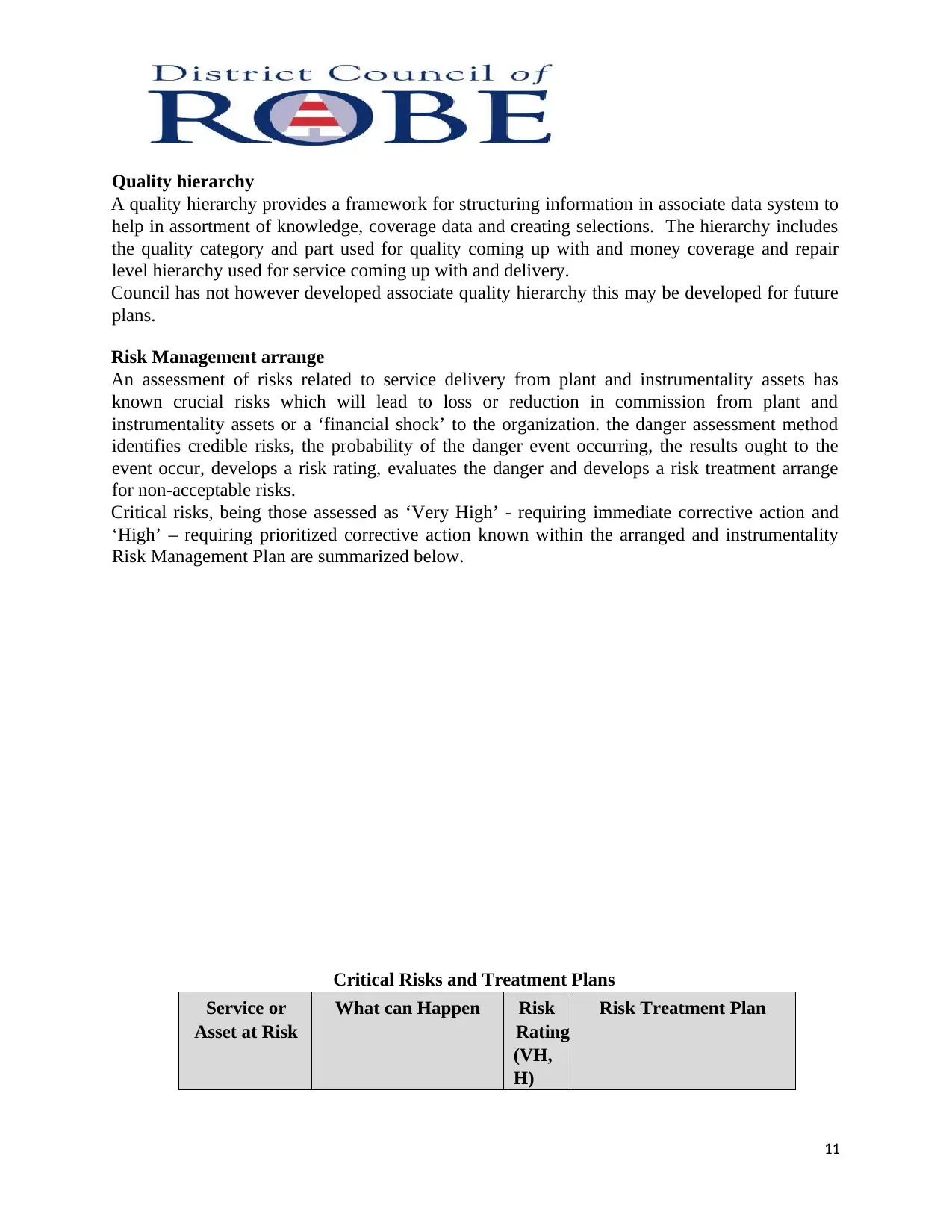
Quality hierarchy
A quality hierarchy provides a framework for structuring information in associate data system to
help in assortment of knowledge, coverage data and creating selections. The hierarchy includes
the quality category and part used for quality coming up with and money coverage and repair
level hierarchy used for service coming up with and delivery.
Council has not however developed associate quality hierarchy this may be developed for future
plans.
Risk Management arrange
An assessment of risks related to service delivery from plant and instrumentality assets has
known crucial risks which will lead to loss or reduction in commission from plant and
instrumentality assets or a ‘financial shock’ to the organization. the danger assessment method
identifies credible risks, the probability of the danger event occurring, the results ought to the
event occur, develops a risk rating, evaluates the danger and develops a risk treatment arrange
for non-acceptable risks.
Critical risks, being those assessed as ‘Very High’ - requiring immediate corrective action and
‘High’ – requiring prioritized corrective action known within the arranged and instrumentality
Risk Management Plan are summarized below.
Critical Risks and Treatment Plans
Service or
Asset at Risk
What can Happen Risk
Rating
(VH,
H)
Risk Treatment Plan
11
A quality hierarchy provides a framework for structuring information in associate data system to
help in assortment of knowledge, coverage data and creating selections. The hierarchy includes
the quality category and part used for quality coming up with and money coverage and repair
level hierarchy used for service coming up with and delivery.
Council has not however developed associate quality hierarchy this may be developed for future
plans.
Risk Management arrange
An assessment of risks related to service delivery from plant and instrumentality assets has
known crucial risks which will lead to loss or reduction in commission from plant and
instrumentality assets or a ‘financial shock’ to the organization. the danger assessment method
identifies credible risks, the probability of the danger event occurring, the results ought to the
event occur, develops a risk rating, evaluates the danger and develops a risk treatment arrange
for non-acceptable risks.
Critical risks, being those assessed as ‘Very High’ - requiring immediate corrective action and
‘High’ – requiring prioritized corrective action known within the arranged and instrumentality
Risk Management Plan are summarized below.
Critical Risks and Treatment Plans
Service or
Asset at Risk
What can Happen Risk
Rating
(VH,
H)
Risk Treatment Plan
11
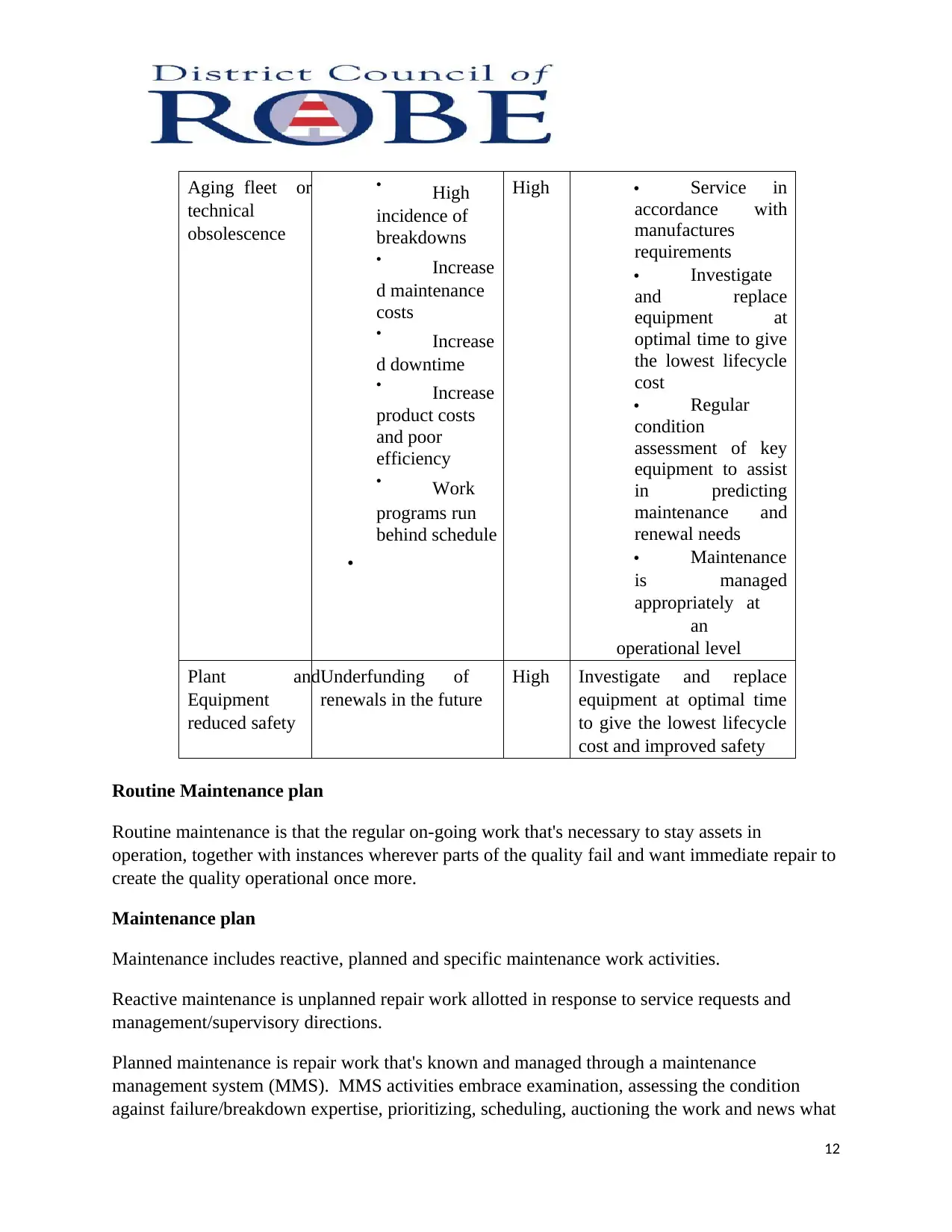
Aging fleet
technical
obsolescence
or • High
incidence of
breakdowns
• Increase
d maintenance
costs
• Increase
d downtime
• Increase
product costs
and poor
efficiency
• Work
programs run
behind schedule
•
High • Service in
accordance with
manufactures
requirements
• Investigate
and replace
equipment at
optimal time to give
the lowest lifecycle
cost
• Regular
condition
assessment of key
equipment to assist
in predicting
maintenance and
renewal needs
• Maintenance
is managed
appropriately at
an
operational level
Plant and
Equipment
reduced safety
Underfunding of
renewals in the future
High Investigate and replace
equipment at optimal time
to give the lowest lifecycle
cost and improved safety
Routine Maintenance plan
Routine maintenance is that the regular on-going work that's necessary to stay assets in
operation, together with instances wherever parts of the quality fail and want immediate repair to
create the quality operational once more.
Maintenance plan
Maintenance includes reactive, planned and specific maintenance work activities.
Reactive maintenance is unplanned repair work allotted in response to service requests and
management/supervisory directions.
Planned maintenance is repair work that's known and managed through a maintenance
management system (MMS). MMS activities embrace examination, assessing the condition
against failure/breakdown expertise, prioritizing, scheduling, auctioning the work and news what
12
technical
obsolescence
or • High
incidence of
breakdowns
• Increase
d maintenance
costs
• Increase
d downtime
• Increase
product costs
and poor
efficiency
• Work
programs run
behind schedule
•
High • Service in
accordance with
manufactures
requirements
• Investigate
and replace
equipment at
optimal time to give
the lowest lifecycle
cost
• Regular
condition
assessment of key
equipment to assist
in predicting
maintenance and
renewal needs
• Maintenance
is managed
appropriately at
an
operational level
Plant and
Equipment
reduced safety
Underfunding of
renewals in the future
High Investigate and replace
equipment at optimal time
to give the lowest lifecycle
cost and improved safety
Routine Maintenance plan
Routine maintenance is that the regular on-going work that's necessary to stay assets in
operation, together with instances wherever parts of the quality fail and want immediate repair to
create the quality operational once more.
Maintenance plan
Maintenance includes reactive, planned and specific maintenance work activities.
Reactive maintenance is unplanned repair work allotted in response to service requests and
management/supervisory directions.
Planned maintenance is repair work that's known and managed through a maintenance
management system (MMS). MMS activities embrace examination, assessing the condition
against failure/breakdown expertise, prioritizing, scheduling, auctioning the work and news what
12
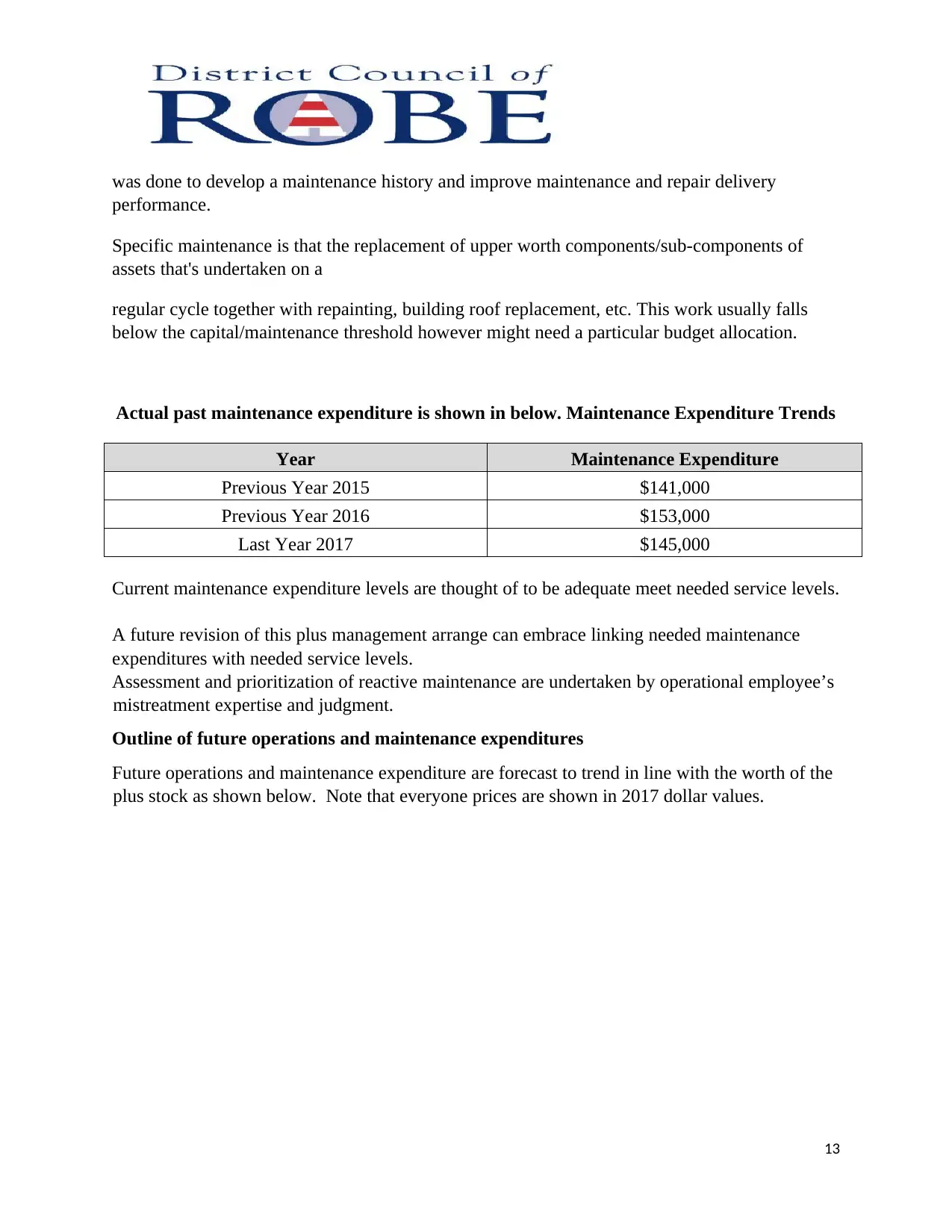
was done to develop a maintenance history and improve maintenance and repair delivery
performance.
Specific maintenance is that the replacement of upper worth components/sub-components of
assets that's undertaken on a
regular cycle together with repainting, building roof replacement, etc. This work usually falls
below the capital/maintenance threshold however might need a particular budget allocation.
Actual past maintenance expenditure is shown in below. Maintenance Expenditure Trends
Year Maintenance Expenditure
Previous Year 2015 $141,000
Previous Year 2016 $153,000
Last Year 2017 $145,000
Current maintenance expenditure levels are thought of to be adequate meet needed service levels.
A future revision of this plus management arrange can embrace linking needed maintenance
expenditures with needed service levels.
Assessment and prioritization of reactive maintenance are undertaken by operational employee’s
mistreatment expertise and judgment.
Outline of future operations and maintenance expenditures
Future operations and maintenance expenditure are forecast to trend in line with the worth of the
plus stock as shown below. Note that everyone prices are shown in 2017 dollar values.
13
performance.
Specific maintenance is that the replacement of upper worth components/sub-components of
assets that's undertaken on a
regular cycle together with repainting, building roof replacement, etc. This work usually falls
below the capital/maintenance threshold however might need a particular budget allocation.
Actual past maintenance expenditure is shown in below. Maintenance Expenditure Trends
Year Maintenance Expenditure
Previous Year 2015 $141,000
Previous Year 2016 $153,000
Last Year 2017 $145,000
Current maintenance expenditure levels are thought of to be adequate meet needed service levels.
A future revision of this plus management arrange can embrace linking needed maintenance
expenditures with needed service levels.
Assessment and prioritization of reactive maintenance are undertaken by operational employee’s
mistreatment expertise and judgment.
Outline of future operations and maintenance expenditures
Future operations and maintenance expenditure are forecast to trend in line with the worth of the
plus stock as shown below. Note that everyone prices are shown in 2017 dollar values.
13
Paraphrase This Document
Need a fresh take? Get an instant paraphrase of this document with our AI Paraphraser
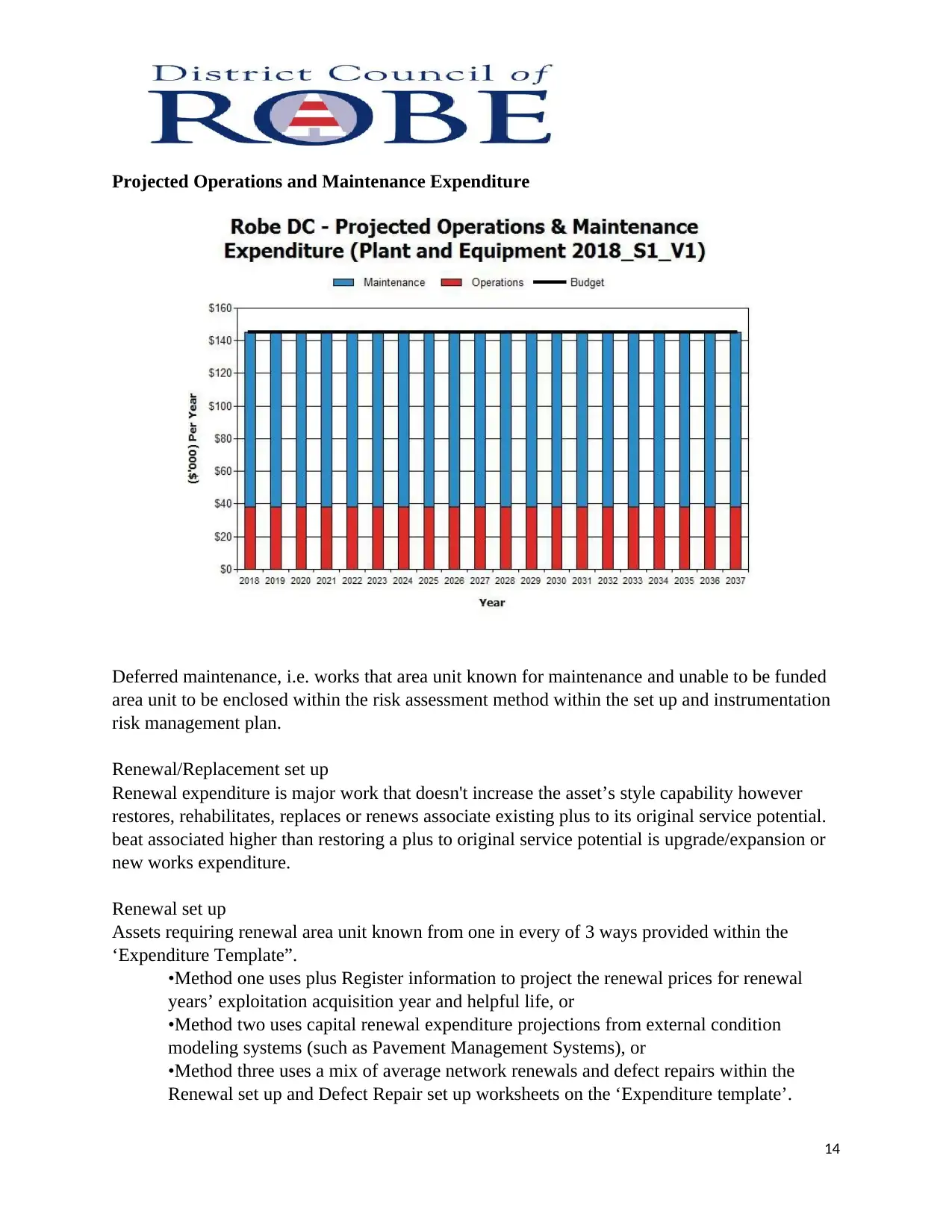
Projected Operations and Maintenance Expenditure
Deferred maintenance, i.e. works that area unit known for maintenance and unable to be funded
area unit to be enclosed within the risk assessment method within the set up and instrumentation
risk management plan.
Renewal/Replacement set up
Renewal expenditure is major work that doesn't increase the asset’s style capability however
restores, rehabilitates, replaces or renews associate existing plus to its original service potential.
beat associated higher than restoring a plus to original service potential is upgrade/expansion or
new works expenditure.
Renewal set up
Assets requiring renewal area unit known from one in every of 3 ways provided within the
‘Expenditure Template”.
•Method one uses plus Register information to project the renewal prices for renewal
years’ exploitation acquisition year and helpful life, or
•Method two uses capital renewal expenditure projections from external condition
modeling systems (such as Pavement Management Systems), or
•Method three uses a mix of average network renewals and defect repairs within the
Renewal set up and Defect Repair set up worksheets on the ‘Expenditure template’.
14
Deferred maintenance, i.e. works that area unit known for maintenance and unable to be funded
area unit to be enclosed within the risk assessment method within the set up and instrumentation
risk management plan.
Renewal/Replacement set up
Renewal expenditure is major work that doesn't increase the asset’s style capability however
restores, rehabilitates, replaces or renews associate existing plus to its original service potential.
beat associated higher than restoring a plus to original service potential is upgrade/expansion or
new works expenditure.
Renewal set up
Assets requiring renewal area unit known from one in every of 3 ways provided within the
‘Expenditure Template”.
•Method one uses plus Register information to project the renewal prices for renewal
years’ exploitation acquisition year and helpful life, or
•Method two uses capital renewal expenditure projections from external condition
modeling systems (such as Pavement Management Systems), or
•Method three uses a mix of average network renewals and defect repairs within the
Renewal set up and Defect Repair set up worksheets on the ‘Expenditure template’.
14
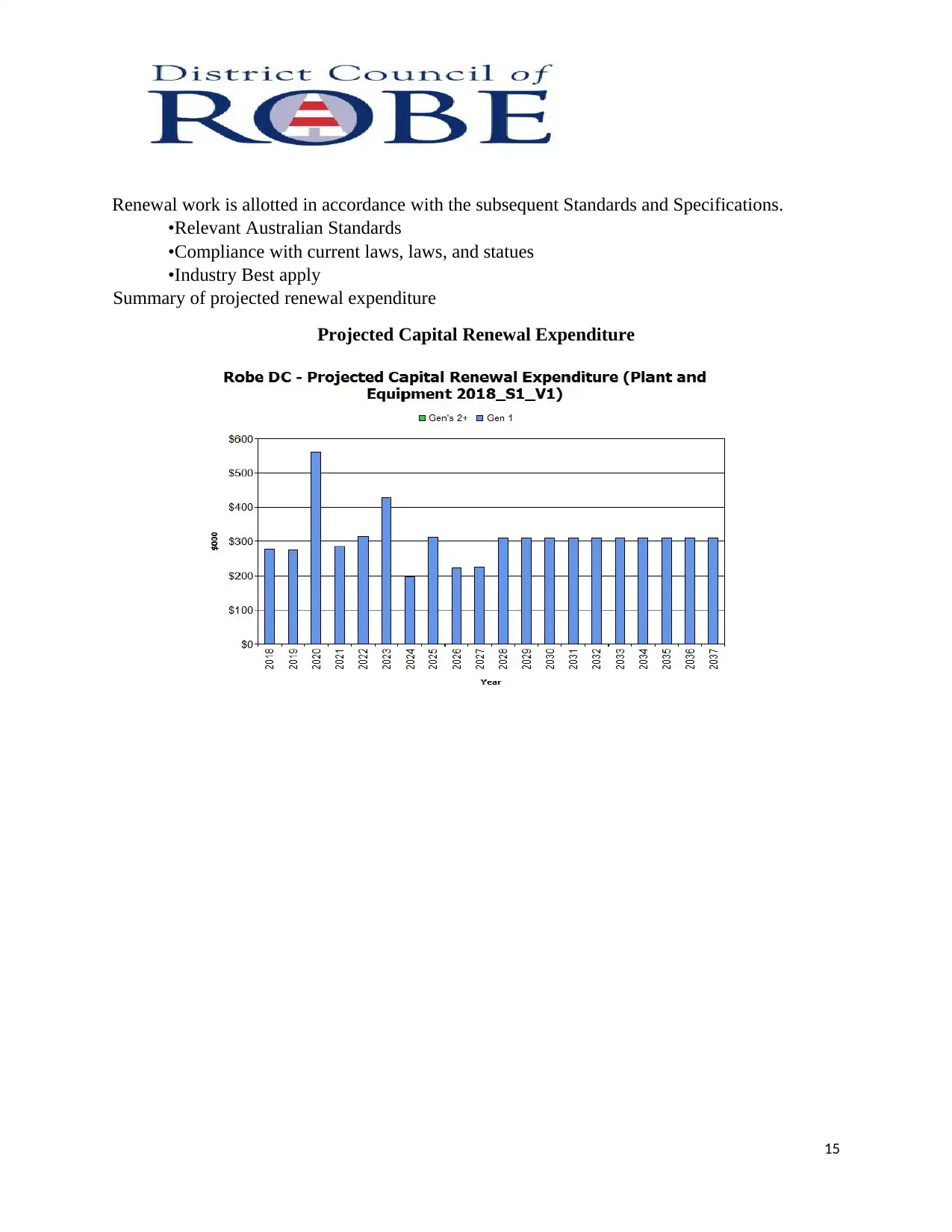
Renewal work is allotted in accordance with the subsequent Standards and Specifications.
•Relevant Australian Standards
•Compliance with current laws, laws, and statues
•Industry Best apply
Summary of projected renewal expenditure
Projected Capital Renewal Expenditure
15
•Relevant Australian Standards
•Compliance with current laws, laws, and statues
•Industry Best apply
Summary of projected renewal expenditure
Projected Capital Renewal Expenditure
15
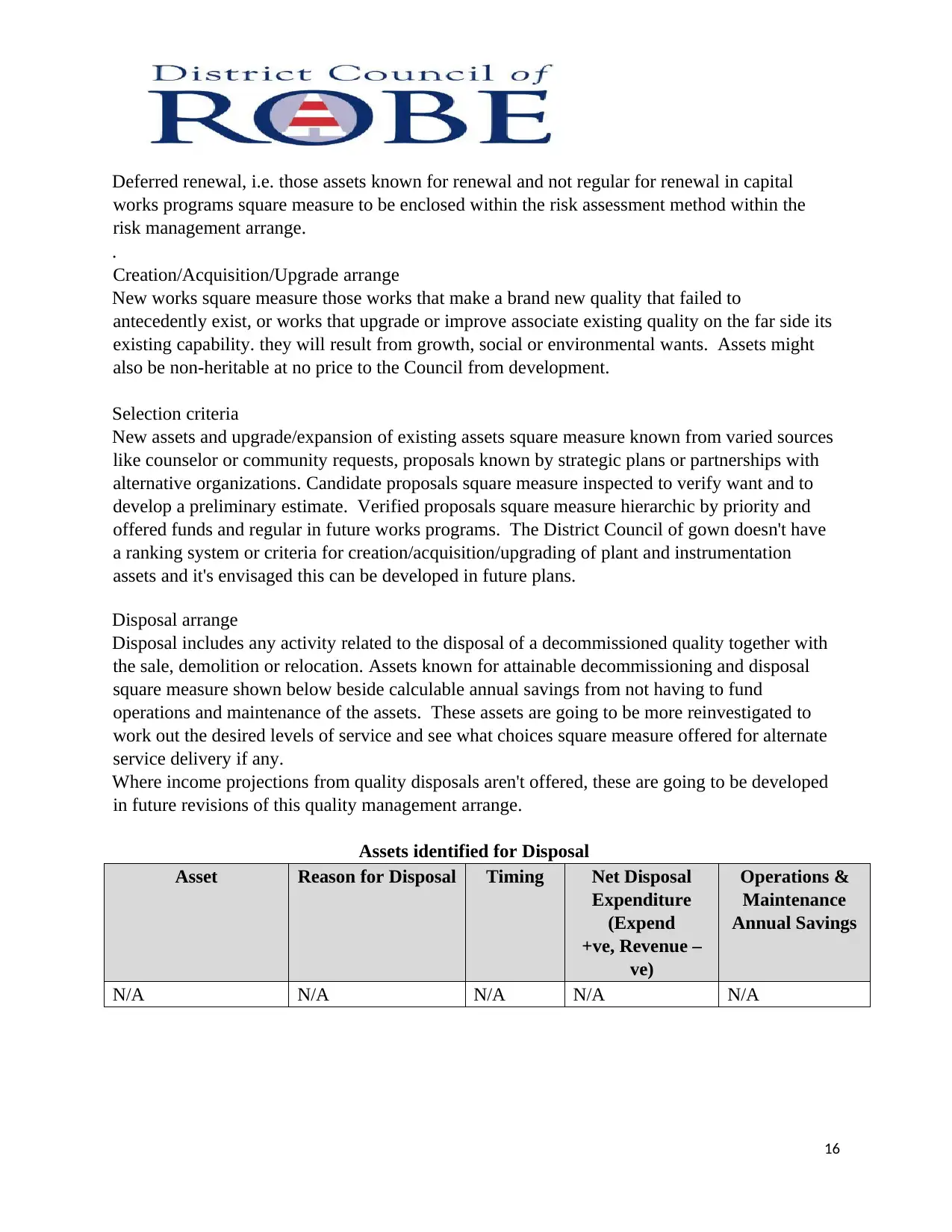
Deferred renewal, i.e. those assets known for renewal and not regular for renewal in capital
works programs square measure to be enclosed within the risk assessment method within the
risk management arrange.
.
Creation/Acquisition/Upgrade arrange
New works square measure those works that make a brand new quality that failed to
antecedently exist, or works that upgrade or improve associate existing quality on the far side its
existing capability. they will result from growth, social or environmental wants. Assets might
also be non-heritable at no price to the Council from development.
Selection criteria
New assets and upgrade/expansion of existing assets square measure known from varied sources
like counselor or community requests, proposals known by strategic plans or partnerships with
alternative organizations. Candidate proposals square measure inspected to verify want and to
develop a preliminary estimate. Verified proposals square measure hierarchic by priority and
offered funds and regular in future works programs. The District Council of gown doesn't have
a ranking system or criteria for creation/acquisition/upgrading of plant and instrumentation
assets and it's envisaged this can be developed in future plans.
Disposal arrange
Disposal includes any activity related to the disposal of a decommissioned quality together with
the sale, demolition or relocation. Assets known for attainable decommissioning and disposal
square measure shown below beside calculable annual savings from not having to fund
operations and maintenance of the assets. These assets are going to be more reinvestigated to
work out the desired levels of service and see what choices square measure offered for alternate
service delivery if any.
Where income projections from quality disposals aren't offered, these are going to be developed
in future revisions of this quality management arrange.
Assets identified for Disposal
Asset Reason for Disposal Timing Net Disposal
Expenditure
(Expend
+ve, Revenue –
ve)
Operations &
Maintenance
Annual Savings
N/A N/A N/A N/A N/A
16
works programs square measure to be enclosed within the risk assessment method within the
risk management arrange.
.
Creation/Acquisition/Upgrade arrange
New works square measure those works that make a brand new quality that failed to
antecedently exist, or works that upgrade or improve associate existing quality on the far side its
existing capability. they will result from growth, social or environmental wants. Assets might
also be non-heritable at no price to the Council from development.
Selection criteria
New assets and upgrade/expansion of existing assets square measure known from varied sources
like counselor or community requests, proposals known by strategic plans or partnerships with
alternative organizations. Candidate proposals square measure inspected to verify want and to
develop a preliminary estimate. Verified proposals square measure hierarchic by priority and
offered funds and regular in future works programs. The District Council of gown doesn't have
a ranking system or criteria for creation/acquisition/upgrading of plant and instrumentation
assets and it's envisaged this can be developed in future plans.
Disposal arrange
Disposal includes any activity related to the disposal of a decommissioned quality together with
the sale, demolition or relocation. Assets known for attainable decommissioning and disposal
square measure shown below beside calculable annual savings from not having to fund
operations and maintenance of the assets. These assets are going to be more reinvestigated to
work out the desired levels of service and see what choices square measure offered for alternate
service delivery if any.
Where income projections from quality disposals aren't offered, these are going to be developed
in future revisions of this quality management arrange.
Assets identified for Disposal
Asset Reason for Disposal Timing Net Disposal
Expenditure
(Expend
+ve, Revenue –
ve)
Operations &
Maintenance
Annual Savings
N/A N/A N/A N/A N/A
16
Secure Best Marks with AI Grader
Need help grading? Try our AI Grader for instant feedback on your assignments.
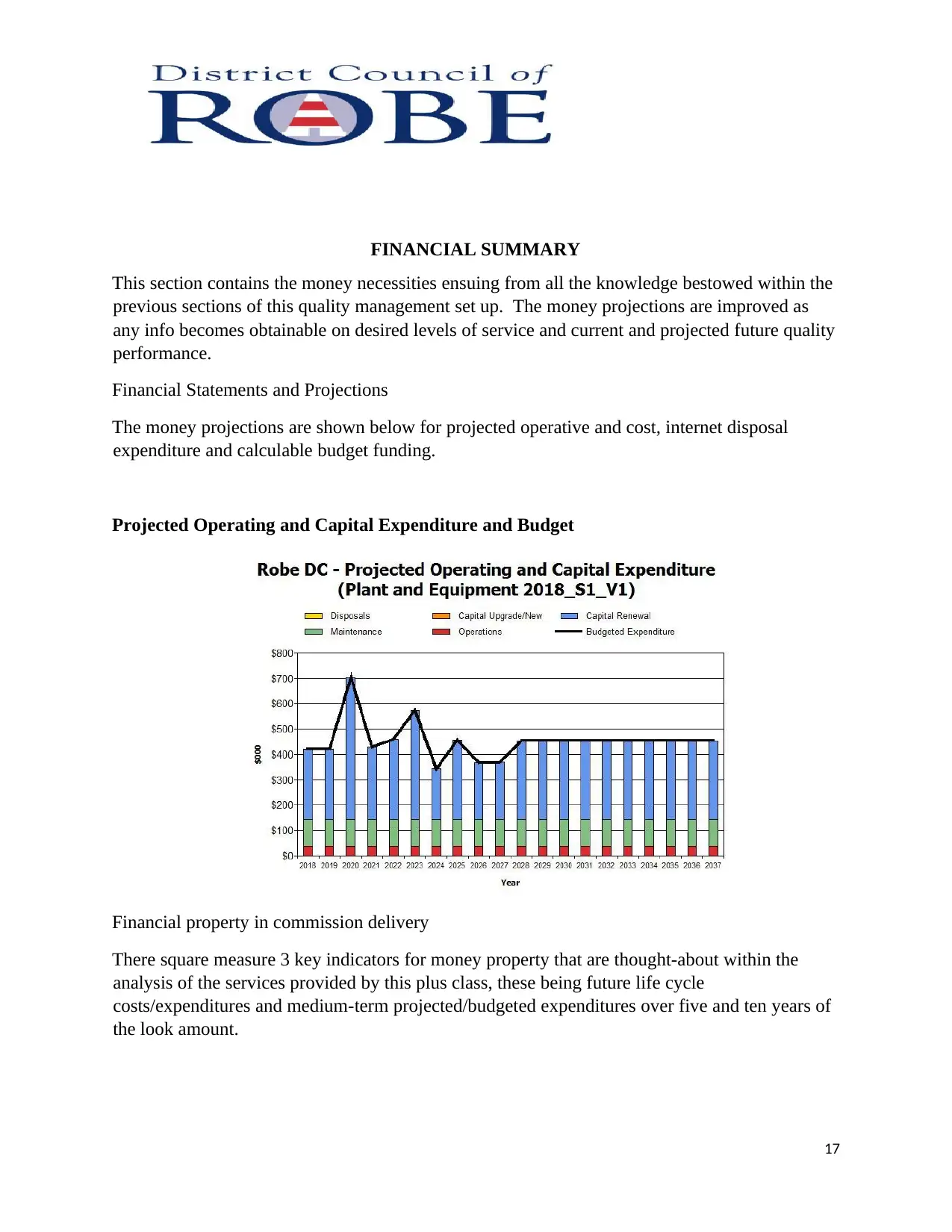
FINANCIAL SUMMARY
This section contains the money necessities ensuing from all the knowledge bestowed within the
previous sections of this quality management set up. The money projections are improved as
any info becomes obtainable on desired levels of service and current and projected future quality
performance.
Financial Statements and Projections
The money projections are shown below for projected operative and cost, internet disposal
expenditure and calculable budget funding.
Projected Operating and Capital Expenditure and Budget
Financial property in commission delivery
There square measure 3 key indicators for money property that are thought-about within the
analysis of the services provided by this plus class, these being future life cycle
costs/expenditures and medium-term projected/budgeted expenditures over five and ten years of
the look amount.
17
This section contains the money necessities ensuing from all the knowledge bestowed within the
previous sections of this quality management set up. The money projections are improved as
any info becomes obtainable on desired levels of service and current and projected future quality
performance.
Financial Statements and Projections
The money projections are shown below for projected operative and cost, internet disposal
expenditure and calculable budget funding.
Projected Operating and Capital Expenditure and Budget
Financial property in commission delivery
There square measure 3 key indicators for money property that are thought-about within the
analysis of the services provided by this plus class, these being future life cycle
costs/expenditures and medium-term projected/budgeted expenditures over five and ten years of
the look amount.
17
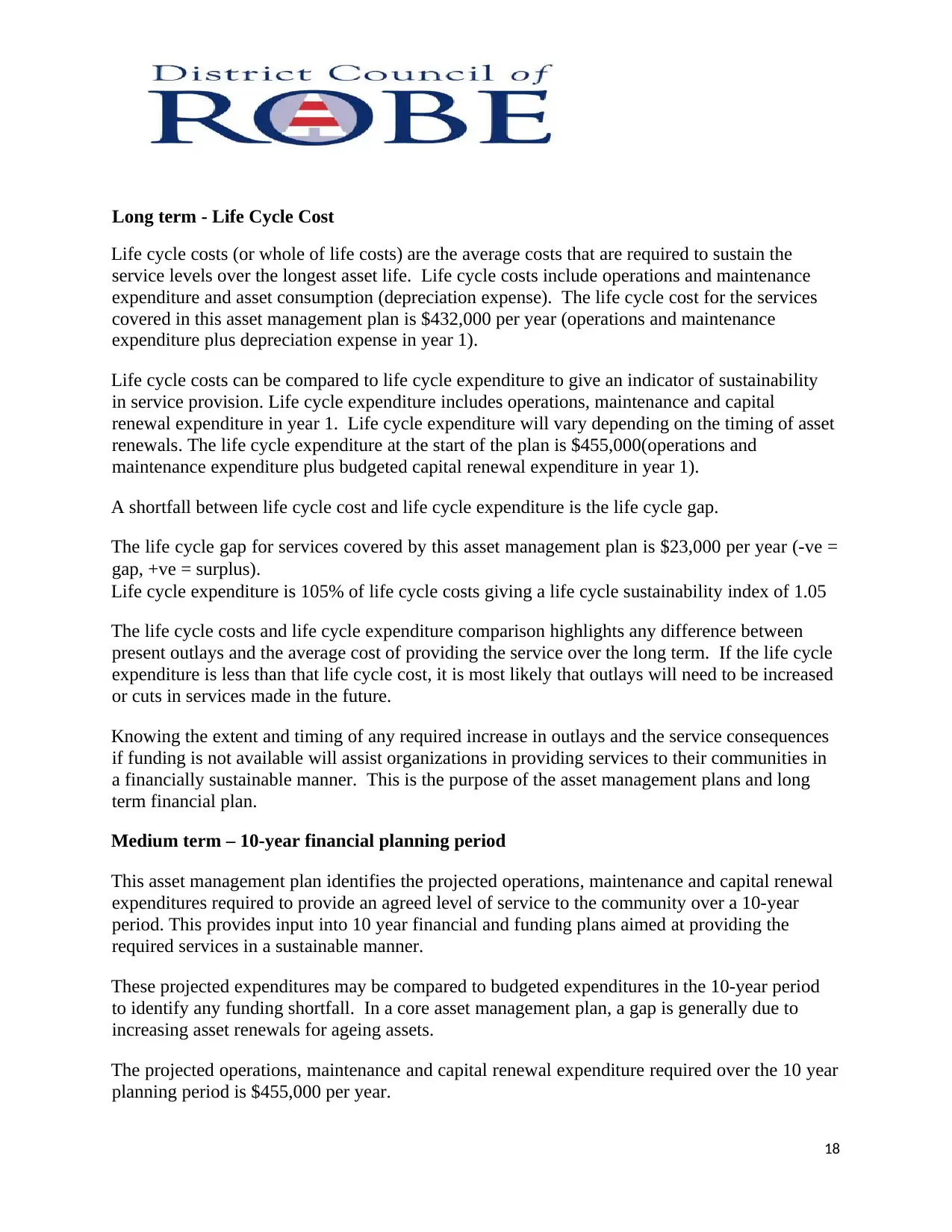
Long term - Life Cycle Cost
Life cycle costs (or whole of life costs) are the average costs that are required to sustain the
service levels over the longest asset life. Life cycle costs include operations and maintenance
expenditure and asset consumption (depreciation expense). The life cycle cost for the services
covered in this asset management plan is $432,000 per year (operations and maintenance
expenditure plus depreciation expense in year 1).
Life cycle costs can be compared to life cycle expenditure to give an indicator of sustainability
in service provision. Life cycle expenditure includes operations, maintenance and capital
renewal expenditure in year 1. Life cycle expenditure will vary depending on the timing of asset
renewals. The life cycle expenditure at the start of the plan is $455,000(operations and
maintenance expenditure plus budgeted capital renewal expenditure in year 1).
A shortfall between life cycle cost and life cycle expenditure is the life cycle gap.
The life cycle gap for services covered by this asset management plan is $23,000 per year (-ve =
gap, +ve = surplus).
Life cycle expenditure is 105% of life cycle costs giving a life cycle sustainability index of 1.05
The life cycle costs and life cycle expenditure comparison highlights any difference between
present outlays and the average cost of providing the service over the long term. If the life cycle
expenditure is less than that life cycle cost, it is most likely that outlays will need to be increased
or cuts in services made in the future.
Knowing the extent and timing of any required increase in outlays and the service consequences
if funding is not available will assist organizations in providing services to their communities in
a financially sustainable manner. This is the purpose of the asset management plans and long
term financial plan.
Medium term – 10-year financial planning period
This asset management plan identifies the projected operations, maintenance and capital renewal
expenditures required to provide an agreed level of service to the community over a 10-year
period. This provides input into 10 year financial and funding plans aimed at providing the
required services in a sustainable manner.
These projected expenditures may be compared to budgeted expenditures in the 10-year period
to identify any funding shortfall. In a core asset management plan, a gap is generally due to
increasing asset renewals for ageing assets.
The projected operations, maintenance and capital renewal expenditure required over the 10 year
planning period is $455,000 per year.
18
Life cycle costs (or whole of life costs) are the average costs that are required to sustain the
service levels over the longest asset life. Life cycle costs include operations and maintenance
expenditure and asset consumption (depreciation expense). The life cycle cost for the services
covered in this asset management plan is $432,000 per year (operations and maintenance
expenditure plus depreciation expense in year 1).
Life cycle costs can be compared to life cycle expenditure to give an indicator of sustainability
in service provision. Life cycle expenditure includes operations, maintenance and capital
renewal expenditure in year 1. Life cycle expenditure will vary depending on the timing of asset
renewals. The life cycle expenditure at the start of the plan is $455,000(operations and
maintenance expenditure plus budgeted capital renewal expenditure in year 1).
A shortfall between life cycle cost and life cycle expenditure is the life cycle gap.
The life cycle gap for services covered by this asset management plan is $23,000 per year (-ve =
gap, +ve = surplus).
Life cycle expenditure is 105% of life cycle costs giving a life cycle sustainability index of 1.05
The life cycle costs and life cycle expenditure comparison highlights any difference between
present outlays and the average cost of providing the service over the long term. If the life cycle
expenditure is less than that life cycle cost, it is most likely that outlays will need to be increased
or cuts in services made in the future.
Knowing the extent and timing of any required increase in outlays and the service consequences
if funding is not available will assist organizations in providing services to their communities in
a financially sustainable manner. This is the purpose of the asset management plans and long
term financial plan.
Medium term – 10-year financial planning period
This asset management plan identifies the projected operations, maintenance and capital renewal
expenditures required to provide an agreed level of service to the community over a 10-year
period. This provides input into 10 year financial and funding plans aimed at providing the
required services in a sustainable manner.
These projected expenditures may be compared to budgeted expenditures in the 10-year period
to identify any funding shortfall. In a core asset management plan, a gap is generally due to
increasing asset renewals for ageing assets.
The projected operations, maintenance and capital renewal expenditure required over the 10 year
planning period is $455,000 per year.
18
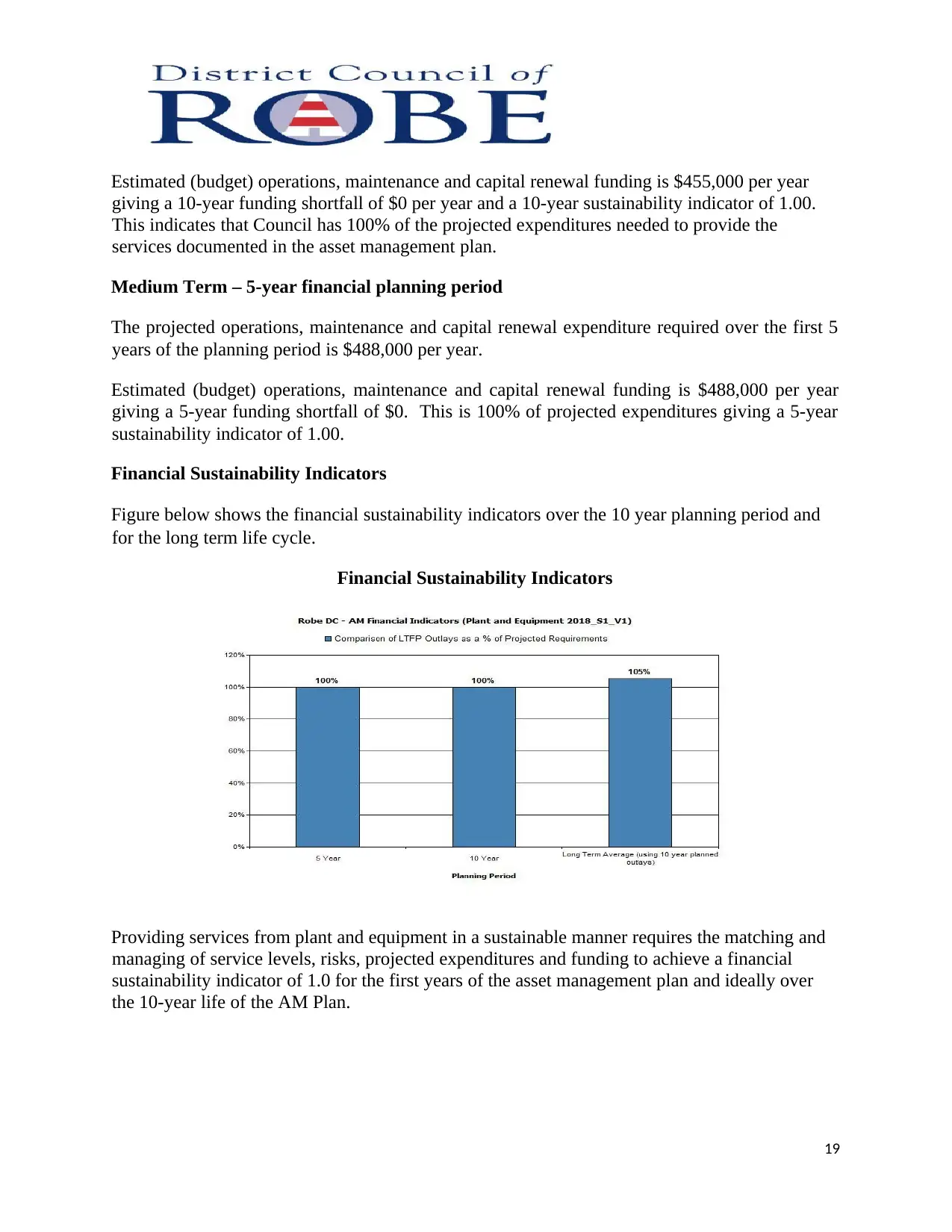
Estimated (budget) operations, maintenance and capital renewal funding is $455,000 per year
giving a 10-year funding shortfall of $0 per year and a 10-year sustainability indicator of 1.00.
This indicates that Council has 100% of the projected expenditures needed to provide the
services documented in the asset management plan.
Medium Term – 5-year financial planning period
The projected operations, maintenance and capital renewal expenditure required over the first 5
years of the planning period is $488,000 per year.
Estimated (budget) operations, maintenance and capital renewal funding is $488,000 per year
giving a 5-year funding shortfall of $0. This is 100% of projected expenditures giving a 5-year
sustainability indicator of 1.00.
Financial Sustainability Indicators
Figure below shows the financial sustainability indicators over the 10 year planning period and
for the long term life cycle.
Financial Sustainability Indicators
Providing services from plant and equipment in a sustainable manner requires the matching and
managing of service levels, risks, projected expenditures and funding to achieve a financial
sustainability indicator of 1.0 for the first years of the asset management plan and ideally over
the 10-year life of the AM Plan.
19
giving a 10-year funding shortfall of $0 per year and a 10-year sustainability indicator of 1.00.
This indicates that Council has 100% of the projected expenditures needed to provide the
services documented in the asset management plan.
Medium Term – 5-year financial planning period
The projected operations, maintenance and capital renewal expenditure required over the first 5
years of the planning period is $488,000 per year.
Estimated (budget) operations, maintenance and capital renewal funding is $488,000 per year
giving a 5-year funding shortfall of $0. This is 100% of projected expenditures giving a 5-year
sustainability indicator of 1.00.
Financial Sustainability Indicators
Figure below shows the financial sustainability indicators over the 10 year planning period and
for the long term life cycle.
Financial Sustainability Indicators
Providing services from plant and equipment in a sustainable manner requires the matching and
managing of service levels, risks, projected expenditures and funding to achieve a financial
sustainability indicator of 1.0 for the first years of the asset management plan and ideally over
the 10-year life of the AM Plan.
19
Paraphrase This Document
Need a fresh take? Get an instant paraphrase of this document with our AI Paraphraser
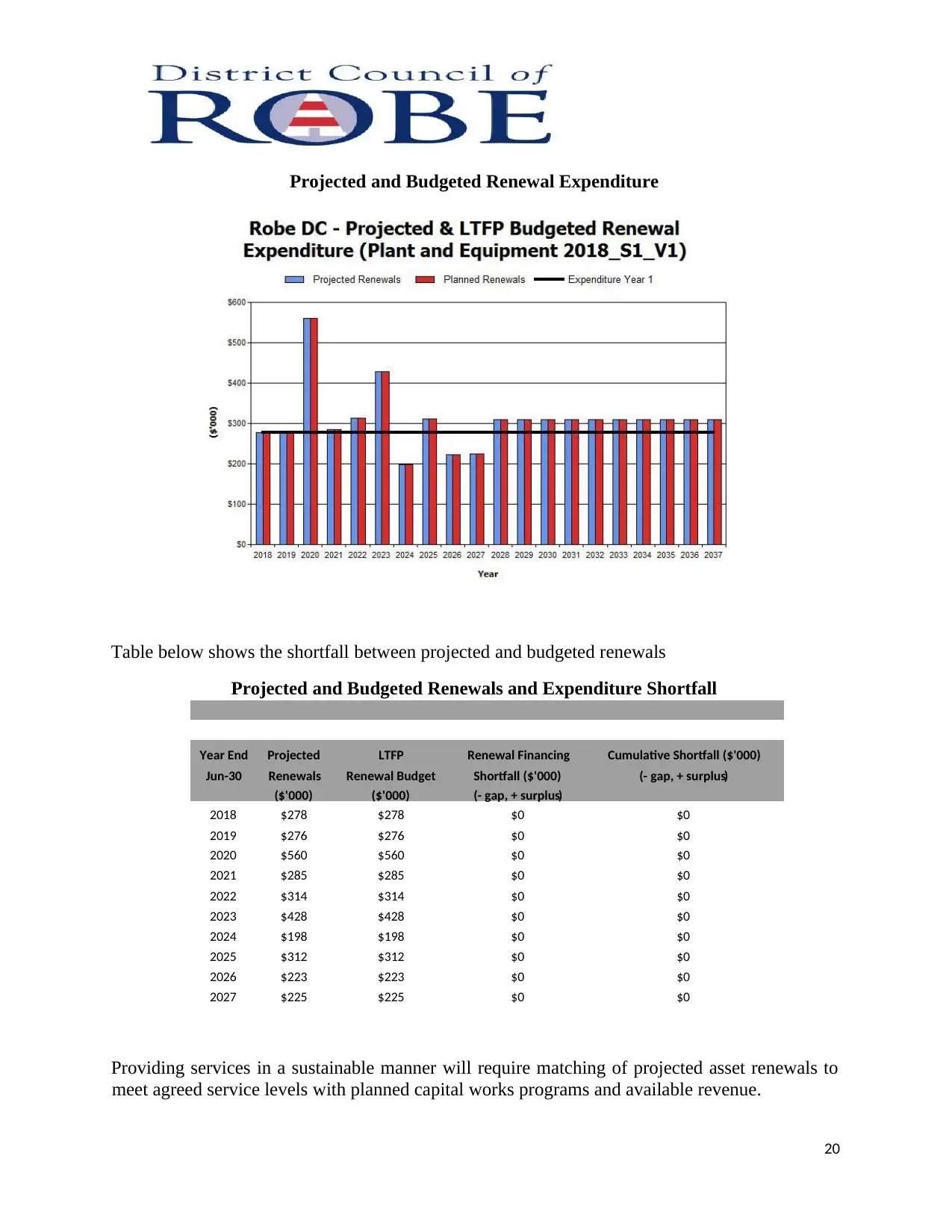
Projected and Budgeted Renewal Expenditure
Table below shows the shortfall between projected and budgeted renewals
Projected and Budgeted Renewals and Expenditure Shortfall
Providing services in a sustainable manner will require matching of projected asset renewals to
meet agreed service levels with planned capital works programs and available revenue.
20
Year End Projected Cumulative Shortfall ($'000)LTFP Renewal Financing
gap, + surplusJun-30 Renewals )Renewal Budget (-Shortfall ($'000)
$'($'000) 000) (- gap, + surplus)(
$0$278 $2782018 $0
$2762019 $0 $0$276
$5602020 $0 $0$560
$2852021 $0 $0$285
$3142022 $0 $0$314
2023 $0$0$428 $428
2024 $0 $0$198 $198
$0$02025 $312 $312
$0$02026 $223 $223
$0$0$2252027 $225
Table below shows the shortfall between projected and budgeted renewals
Projected and Budgeted Renewals and Expenditure Shortfall
Providing services in a sustainable manner will require matching of projected asset renewals to
meet agreed service levels with planned capital works programs and available revenue.
20
Year End Projected Cumulative Shortfall ($'000)LTFP Renewal Financing
gap, + surplusJun-30 Renewals )Renewal Budget (-Shortfall ($'000)
$'($'000) 000) (- gap, + surplus)(
$0$278 $2782018 $0
$2762019 $0 $0$276
$5602020 $0 $0$560
$2852021 $0 $0$285
$3142022 $0 $0$314
2023 $0$0$428 $428
2024 $0 $0$198 $198
$0$02025 $312 $312
$0$02026 $223 $223
$0$0$2252027 $225
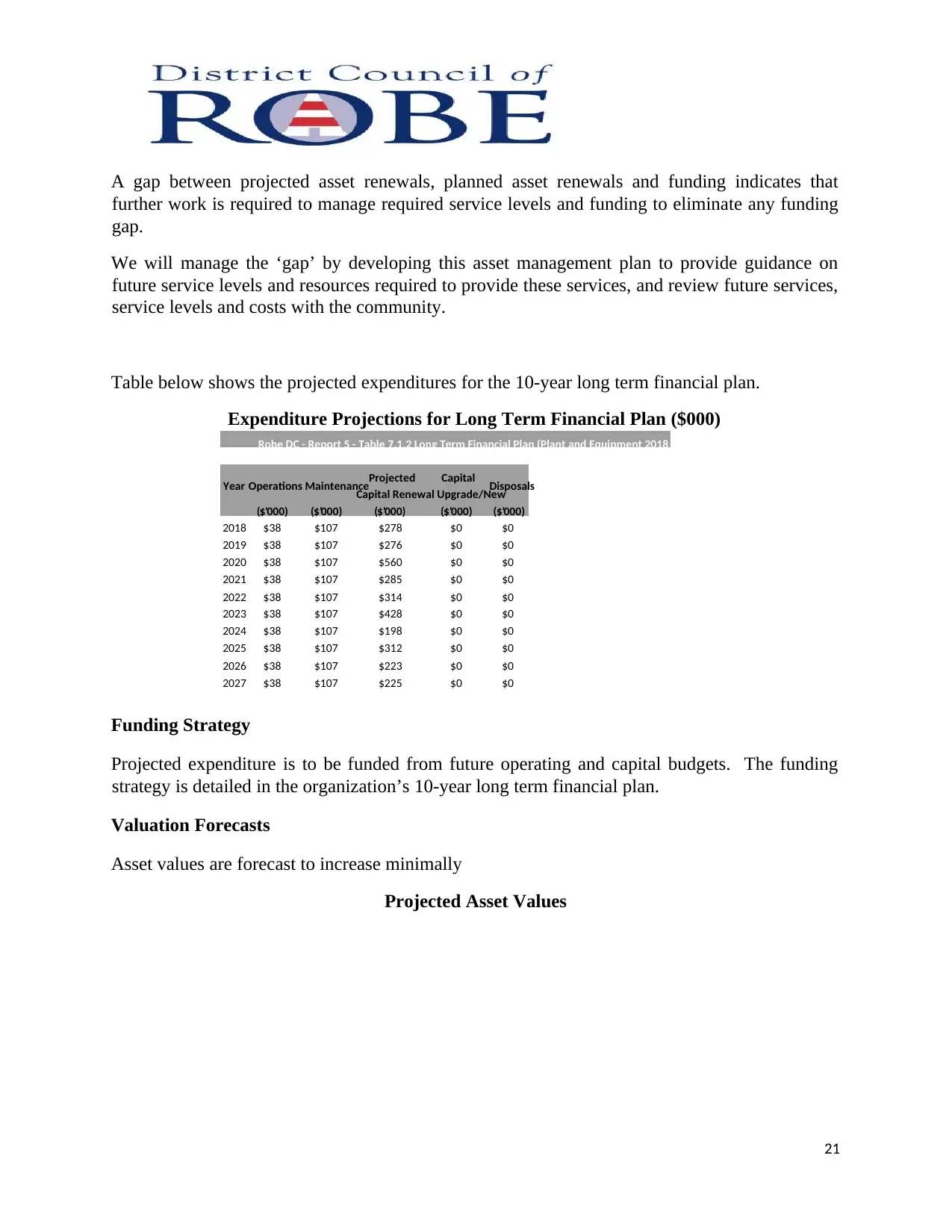
A gap between projected asset renewals, planned asset renewals and funding indicates that
further work is required to manage required service levels and funding to eliminate any funding
gap.
We will manage the ‘gap’ by developing this asset management plan to provide guidance on
future service levels and resources required to provide these services, and review future services,
service levels and costs with the community.
Table below shows the projected expenditures for the 10-year long term financial plan.
Expenditure Projections for Long Term Financial Plan ($000)
Funding Strategy
Projected expenditure is to be funded from future operating and capital budgets. The funding
strategy is detailed in the organization’s 10-year long term financial plan.
Valuation Forecasts
Asset values are forecast to increase minimally
Projected Asset Values
21
Projected Capital
Capital Renewal Upgrade/New
($'000) (($'000) $'($'000) 000)($'000)
$38 $0$278$1072018 $0
$276 $0$1072019 $0$38
2020 $0$107 $0$560$38
$0$107 $02021 $285$38
$1072022 $0$0$314$38
2023 $0$107 $0$38 $428
$0 $0$38 $1072024 $198
$0$0$382025 $107 $312
$0$0$38 $1072026 $223
$0$38 $0$1072027 $225
Robe DC - Report 5 - Table 7.1.2 Long Term Financial Plan (Plant and Equipment 2018_S1_V1)
DisposalsOperations MaintenanceYear
further work is required to manage required service levels and funding to eliminate any funding
gap.
We will manage the ‘gap’ by developing this asset management plan to provide guidance on
future service levels and resources required to provide these services, and review future services,
service levels and costs with the community.
Table below shows the projected expenditures for the 10-year long term financial plan.
Expenditure Projections for Long Term Financial Plan ($000)
Funding Strategy
Projected expenditure is to be funded from future operating and capital budgets. The funding
strategy is detailed in the organization’s 10-year long term financial plan.
Valuation Forecasts
Asset values are forecast to increase minimally
Projected Asset Values
21
Projected Capital
Capital Renewal Upgrade/New
($'000) (($'000) $'($'000) 000)($'000)
$38 $0$278$1072018 $0
$276 $0$1072019 $0$38
2020 $0$107 $0$560$38
$0$107 $02021 $285$38
$1072022 $0$0$314$38
2023 $0$107 $0$38 $428
$0 $0$38 $1072024 $198
$0$0$382025 $107 $312
$0$0$38 $1072026 $223
$0$38 $0$1072027 $225
Robe DC - Report 5 - Table 7.1.2 Long Term Financial Plan (Plant and Equipment 2018_S1_V1)
DisposalsOperations MaintenanceYear
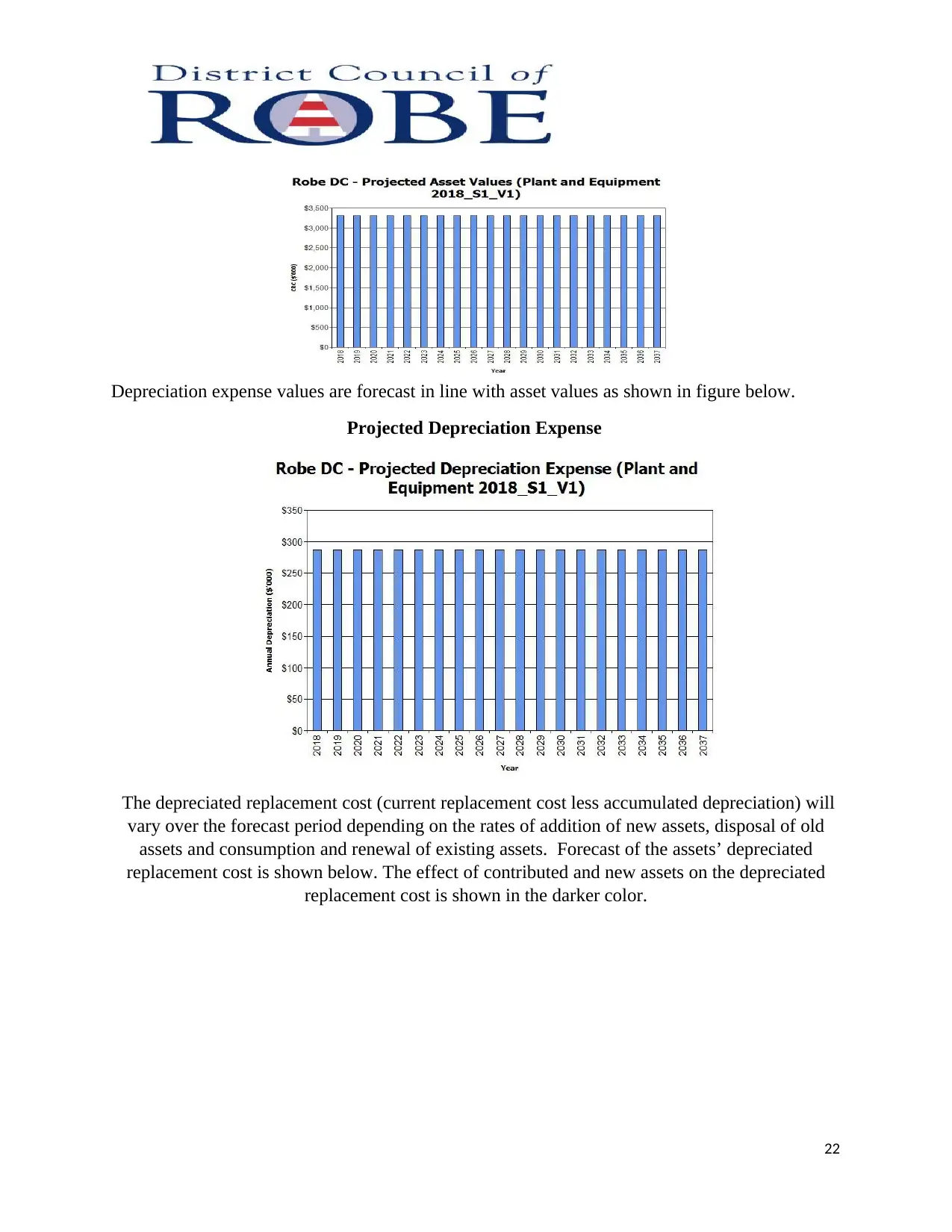
Depreciation expense values are forecast in line with asset values as shown in figure below.
Projected Depreciation Expense
The depreciated replacement cost (current replacement cost less accumulated depreciation) will
vary over the forecast period depending on the rates of addition of new assets, disposal of old
assets and consumption and renewal of existing assets. Forecast of the assets’ depreciated
replacement cost is shown below. The effect of contributed and new assets on the depreciated
replacement cost is shown in the darker color.
22
Projected Depreciation Expense
The depreciated replacement cost (current replacement cost less accumulated depreciation) will
vary over the forecast period depending on the rates of addition of new assets, disposal of old
assets and consumption and renewal of existing assets. Forecast of the assets’ depreciated
replacement cost is shown below. The effect of contributed and new assets on the depreciated
replacement cost is shown in the darker color.
22
Secure Best Marks with AI Grader
Need help grading? Try our AI Grader for instant feedback on your assignments.
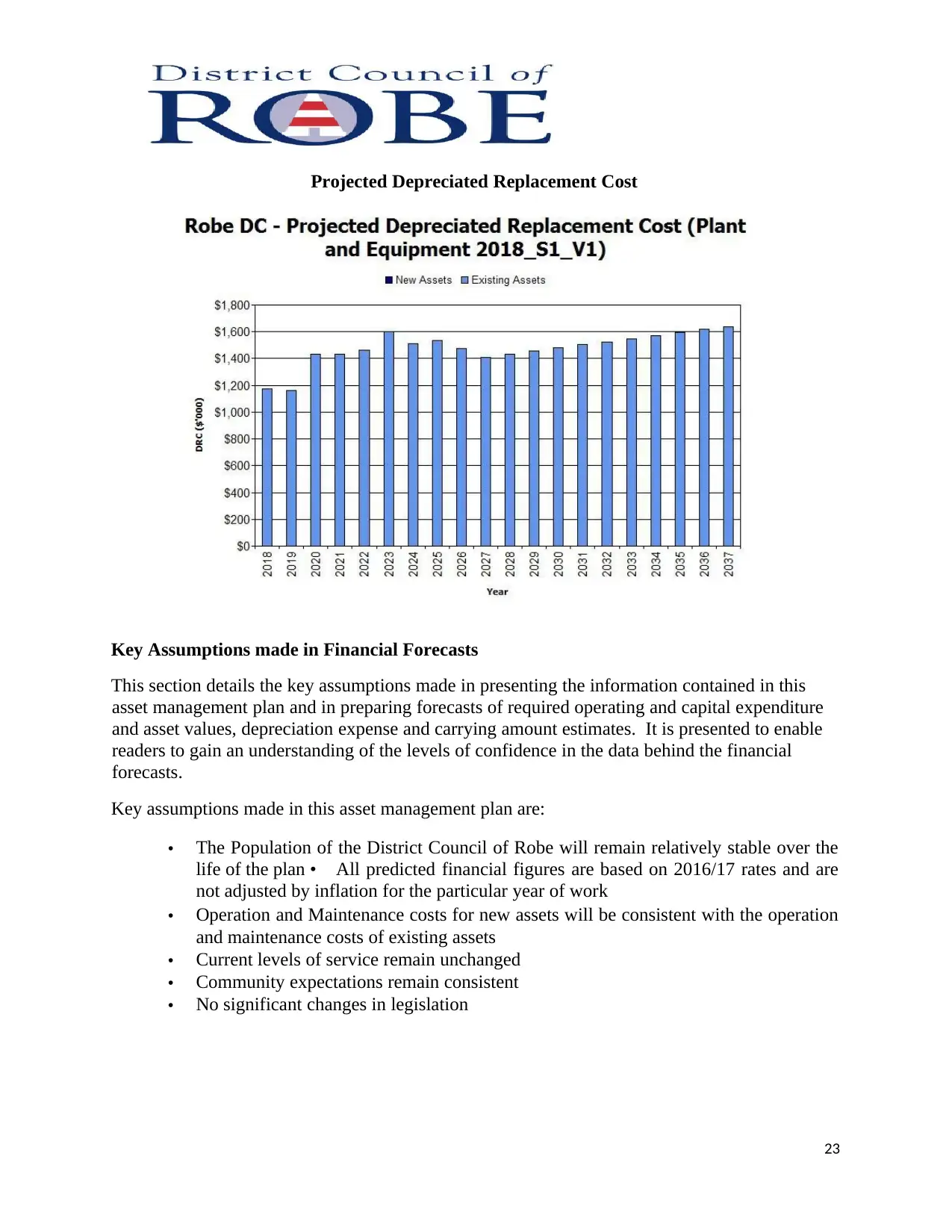
Projected Depreciated Replacement Cost
Key Assumptions made in Financial Forecasts
This section details the key assumptions made in presenting the information contained in this
asset management plan and in preparing forecasts of required operating and capital expenditure
and asset values, depreciation expense and carrying amount estimates. It is presented to enable
readers to gain an understanding of the levels of confidence in the data behind the financial
forecasts.
Key assumptions made in this asset management plan are:
• The Population of the District Council of Robe will remain relatively stable over the
life of the plan • All predicted financial figures are based on 2016/17 rates and are
not adjusted by inflation for the particular year of work
• Operation and Maintenance costs for new assets will be consistent with the operation
and maintenance costs of existing assets
• Current levels of service remain unchanged
• Community expectations remain consistent
• No significant changes in legislation
23
Key Assumptions made in Financial Forecasts
This section details the key assumptions made in presenting the information contained in this
asset management plan and in preparing forecasts of required operating and capital expenditure
and asset values, depreciation expense and carrying amount estimates. It is presented to enable
readers to gain an understanding of the levels of confidence in the data behind the financial
forecasts.
Key assumptions made in this asset management plan are:
• The Population of the District Council of Robe will remain relatively stable over the
life of the plan • All predicted financial figures are based on 2016/17 rates and are
not adjusted by inflation for the particular year of work
• Operation and Maintenance costs for new assets will be consistent with the operation
and maintenance costs of existing assets
• Current levels of service remain unchanged
• Community expectations remain consistent
• No significant changes in legislation
23
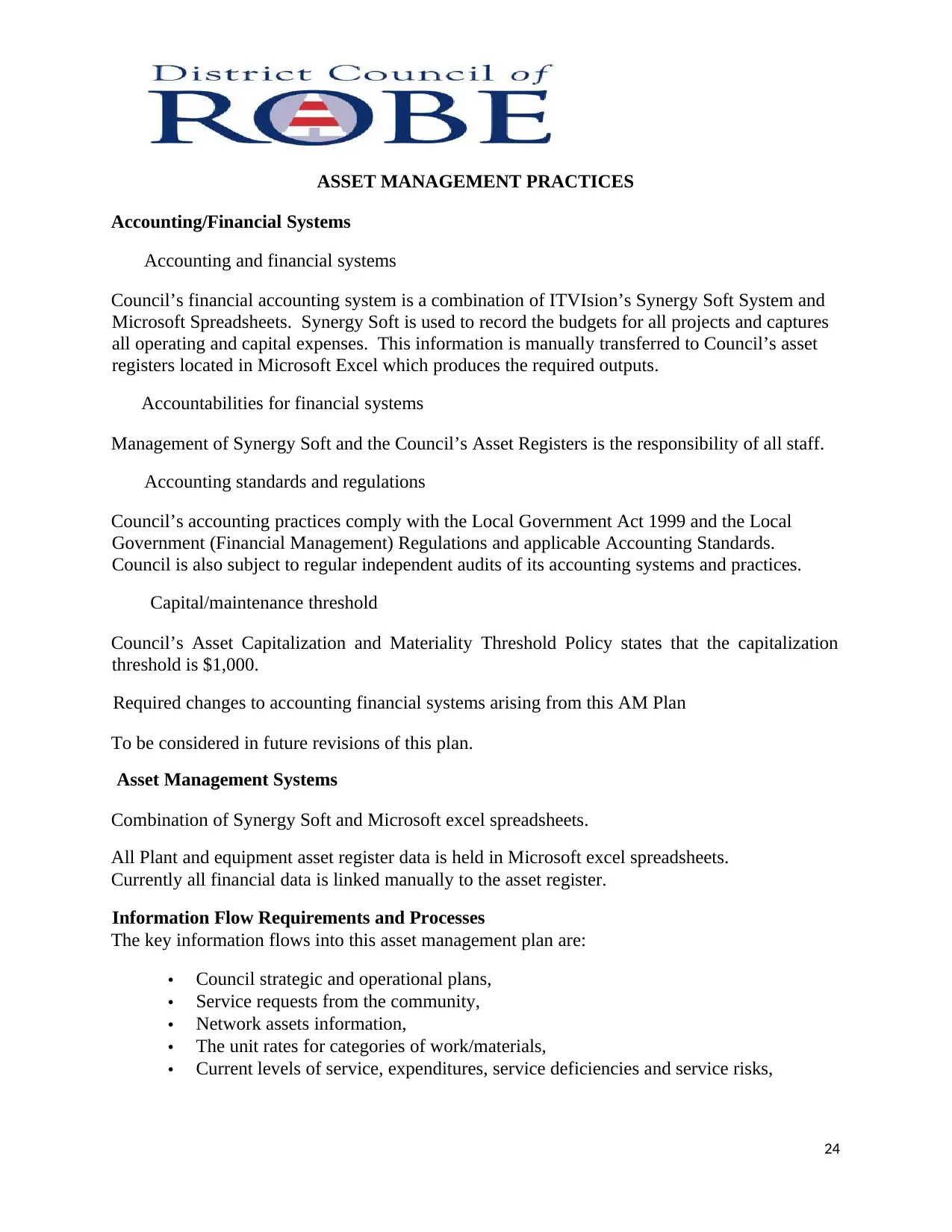
ASSET MANAGEMENT PRACTICES
Accounting/Financial Systems
Accounting and financial systems
Council’s financial accounting system is a combination of ITVIsion’s Synergy Soft System and
Microsoft Spreadsheets. Synergy Soft is used to record the budgets for all projects and captures
all operating and capital expenses. This information is manually transferred to Council’s asset
registers located in Microsoft Excel which produces the required outputs.
Accountabilities for financial systems
Management of Synergy Soft and the Council’s Asset Registers is the responsibility of all staff.
Accounting standards and regulations
Council’s accounting practices comply with the Local Government Act 1999 and the Local
Government (Financial Management) Regulations and applicable Accounting Standards.
Council is also subject to regular independent audits of its accounting systems and practices.
Capital/maintenance threshold
Council’s Asset Capitalization and Materiality Threshold Policy states that the capitalization
threshold is $1,000.
Required changes to accounting financial systems arising from this AM Plan
To be considered in future revisions of this plan.
Asset Management Systems
Combination of Synergy Soft and Microsoft excel spreadsheets.
All Plant and equipment asset register data is held in Microsoft excel spreadsheets.
Currently all financial data is linked manually to the asset register.
Information Flow Requirements and Processes
The key information flows into this asset management plan are:
• Council strategic and operational plans,
• Service requests from the community,
• Network assets information,
• The unit rates for categories of work/materials,
• Current levels of service, expenditures, service deficiencies and service risks,
24
Accounting/Financial Systems
Accounting and financial systems
Council’s financial accounting system is a combination of ITVIsion’s Synergy Soft System and
Microsoft Spreadsheets. Synergy Soft is used to record the budgets for all projects and captures
all operating and capital expenses. This information is manually transferred to Council’s asset
registers located in Microsoft Excel which produces the required outputs.
Accountabilities for financial systems
Management of Synergy Soft and the Council’s Asset Registers is the responsibility of all staff.
Accounting standards and regulations
Council’s accounting practices comply with the Local Government Act 1999 and the Local
Government (Financial Management) Regulations and applicable Accounting Standards.
Council is also subject to regular independent audits of its accounting systems and practices.
Capital/maintenance threshold
Council’s Asset Capitalization and Materiality Threshold Policy states that the capitalization
threshold is $1,000.
Required changes to accounting financial systems arising from this AM Plan
To be considered in future revisions of this plan.
Asset Management Systems
Combination of Synergy Soft and Microsoft excel spreadsheets.
All Plant and equipment asset register data is held in Microsoft excel spreadsheets.
Currently all financial data is linked manually to the asset register.
Information Flow Requirements and Processes
The key information flows into this asset management plan are:
• Council strategic and operational plans,
• Service requests from the community,
• Network assets information,
• The unit rates for categories of work/materials,
• Current levels of service, expenditures, service deficiencies and service risks,
24
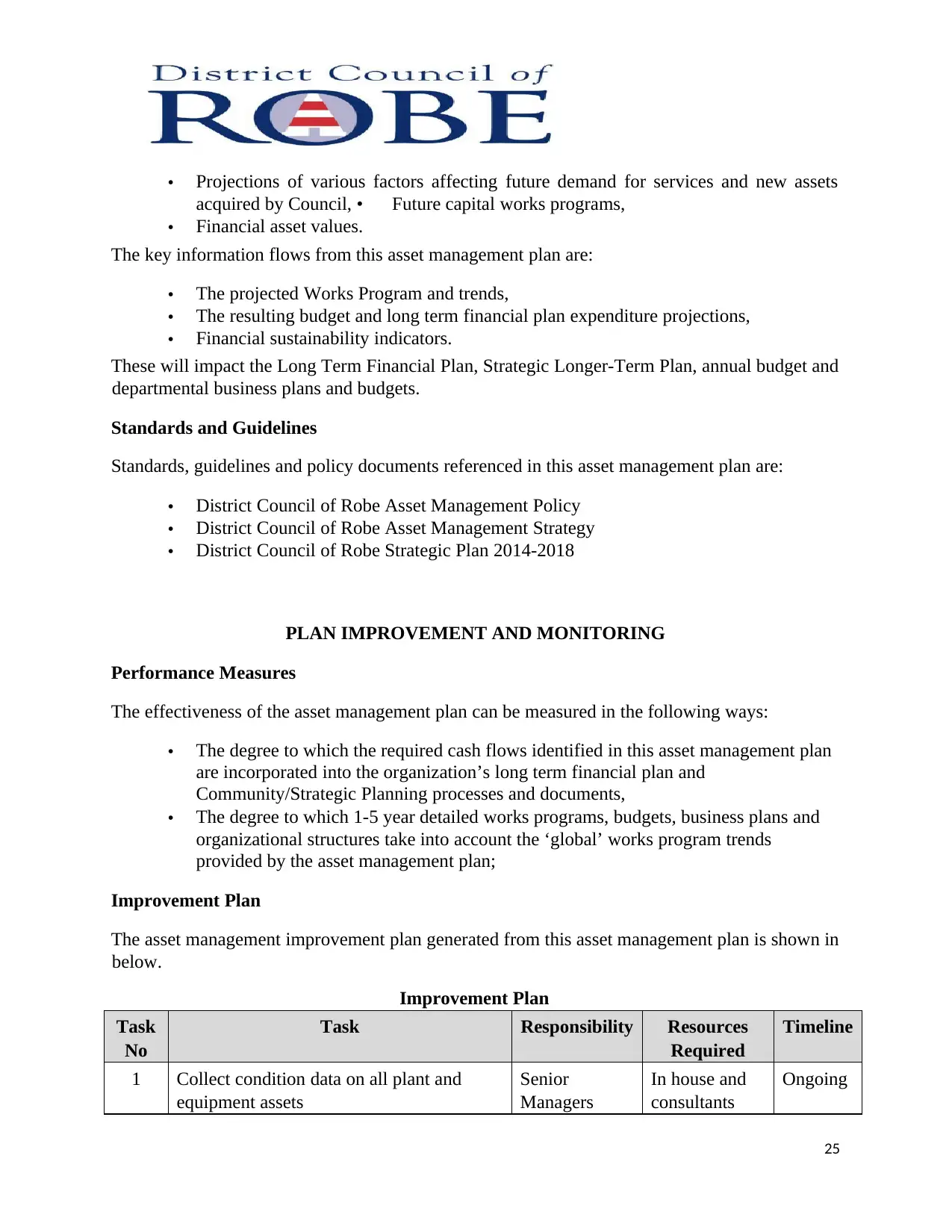
• Projections of various factors affecting future demand for services and new assets
acquired by Council, • Future capital works programs,
• Financial asset values.
The key information flows from this asset management plan are:
• The projected Works Program and trends,
• The resulting budget and long term financial plan expenditure projections,
• Financial sustainability indicators.
These will impact the Long Term Financial Plan, Strategic Longer-Term Plan, annual budget and
departmental business plans and budgets.
Standards and Guidelines
Standards, guidelines and policy documents referenced in this asset management plan are:
• District Council of Robe Asset Management Policy
• District Council of Robe Asset Management Strategy
• District Council of Robe Strategic Plan 2014-2018
PLAN IMPROVEMENT AND MONITORING
Performance Measures
The effectiveness of the asset management plan can be measured in the following ways:
• The degree to which the required cash flows identified in this asset management plan
are incorporated into the organization’s long term financial plan and
Community/Strategic Planning processes and documents,
• The degree to which 1-5 year detailed works programs, budgets, business plans and
organizational structures take into account the ‘global’ works program trends
provided by the asset management plan;
Improvement Plan
The asset management improvement plan generated from this asset management plan is shown in
below.
Improvement Plan
Task
No
Task Responsibility Resources
Required
Timeline
1 Collect condition data on all plant and
equipment assets
Senior
Managers
In house and
consultants
Ongoing
25
acquired by Council, • Future capital works programs,
• Financial asset values.
The key information flows from this asset management plan are:
• The projected Works Program and trends,
• The resulting budget and long term financial plan expenditure projections,
• Financial sustainability indicators.
These will impact the Long Term Financial Plan, Strategic Longer-Term Plan, annual budget and
departmental business plans and budgets.
Standards and Guidelines
Standards, guidelines and policy documents referenced in this asset management plan are:
• District Council of Robe Asset Management Policy
• District Council of Robe Asset Management Strategy
• District Council of Robe Strategic Plan 2014-2018
PLAN IMPROVEMENT AND MONITORING
Performance Measures
The effectiveness of the asset management plan can be measured in the following ways:
• The degree to which the required cash flows identified in this asset management plan
are incorporated into the organization’s long term financial plan and
Community/Strategic Planning processes and documents,
• The degree to which 1-5 year detailed works programs, budgets, business plans and
organizational structures take into account the ‘global’ works program trends
provided by the asset management plan;
Improvement Plan
The asset management improvement plan generated from this asset management plan is shown in
below.
Improvement Plan
Task
No
Task Responsibility Resources
Required
Timeline
1 Collect condition data on all plant and
equipment assets
Senior
Managers
In house and
consultants
Ongoing
25
Paraphrase This Document
Need a fresh take? Get an instant paraphrase of this document with our AI Paraphraser
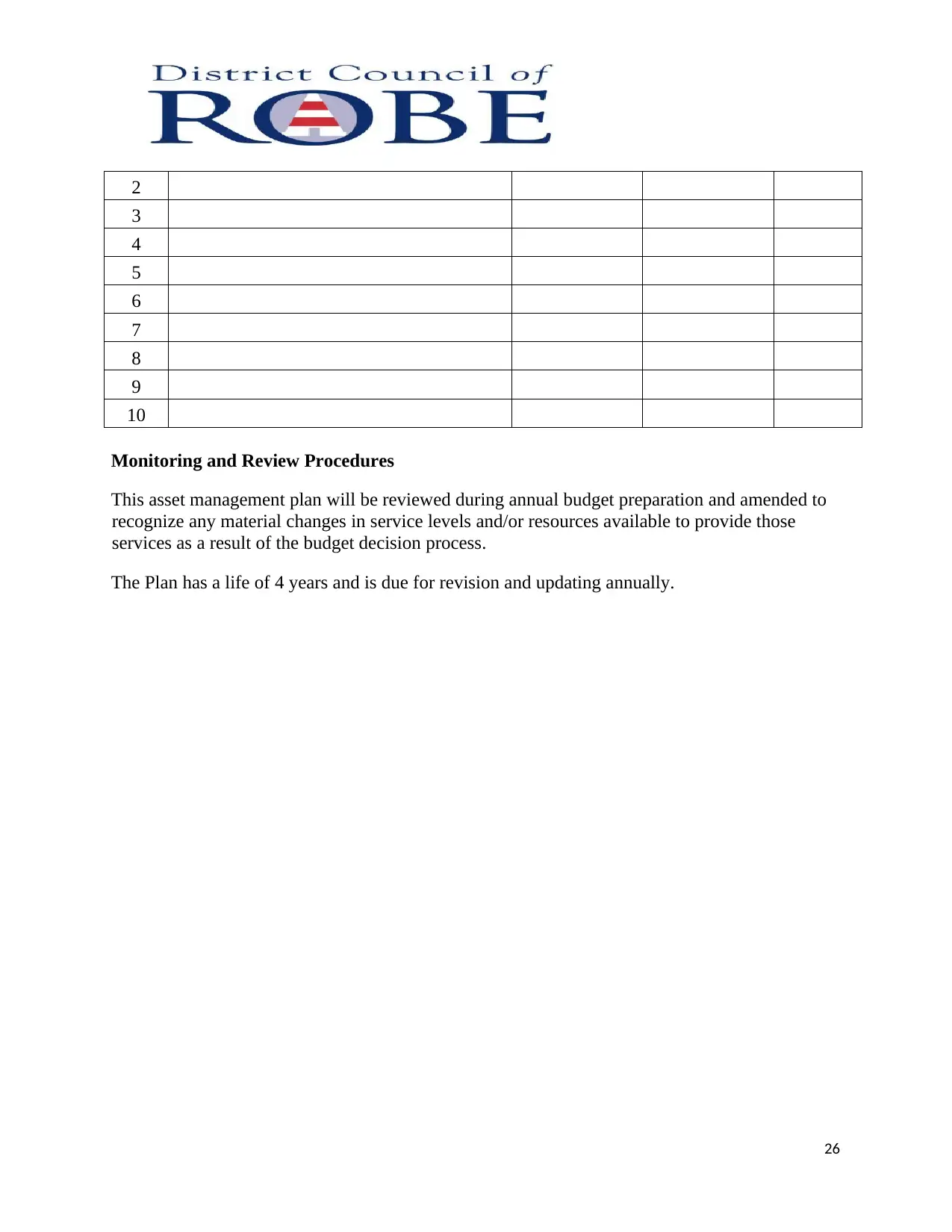
2
3
4
5
6
7
8
9
10
Monitoring and Review Procedures
This asset management plan will be reviewed during annual budget preparation and amended to
recognize any material changes in service levels and/or resources available to provide those
services as a result of the budget decision process.
The Plan has a life of 4 years and is due for revision and updating annually.
26
3
4
5
6
7
8
9
10
Monitoring and Review Procedures
This asset management plan will be reviewed during annual budget preparation and amended to
recognize any material changes in service levels and/or resources available to provide those
services as a result of the budget decision process.
The Plan has a life of 4 years and is due for revision and updating annually.
26
1 out of 26
Your All-in-One AI-Powered Toolkit for Academic Success.
+13062052269
info@desklib.com
Available 24*7 on WhatsApp / Email
![[object Object]](/_next/static/media/star-bottom.7253800d.svg)
Unlock your academic potential
© 2024 | Zucol Services PVT LTD | All rights reserved.